Legal Research Strategy
Preliminary analysis, organization, secondary sources, primary sources, updating research, identifying an end point, getting help, about this guide.
This guide will walk a beginning researcher though the legal research process step-by-step. These materials are created with the 1L Legal Research & Writing course in mind. However, these resources will also assist upper-level students engaged in any legal research project.

How to Strategize
Legal research must be comprehensive and precise. One contrary source that you miss may invalidate other sources you plan to rely on. Sticking to a strategy will save you time, ensure completeness, and improve your work product.
Follow These Steps
Running Time: 3 minutes, 13 seconds.
Make sure that you don't miss any steps by using our:
- Legal Research Strategy Checklist
If you get stuck at any time during the process, check this out:
- Ten Tips for Moving Beyond the Brick Wall in the Legal Research Process, by Marsha L. Baum
Understanding the Legal Questions
A legal question often originates as a problem or story about a series of events. In law school, these stories are called fact patterns. In practice, facts may arise from a manager or an interview with a potential client. Start by doing the following:

- Read anything you have been given
- Analyze the facts and frame the legal issues
- Assess what you know and need to learn
- Note the jurisdiction and any primary law you have been given
- Generate potential search terms
Jurisdiction
Legal rules will vary depending on where geographically your legal question will be answered. You must determine the jurisdiction in which your claim will be heard. These resources can help you learn more about jurisdiction and how it is determined:
- Legal Treatises on Jurisdiction
- LII Wex Entry on Jurisdiction
This map indicates which states are in each federal appellate circuit:

Getting Started
Once you have begun your research, you will need to keep track of your work. Logging your research will help you to avoid missing sources and explain your research strategy. You will likely be asked to explain your research process when in practice. Researchers can keep paper logs, folders on Westlaw or Lexis, or online citation management platforms.
Organizational Methods
Tracking with paper or excel.
Many researchers create their own tracking charts. Be sure to include:
- Search Date
- Topics/Keywords/Search Strategy
- Citation to Relevant Source Found
- Save Locations
- Follow Up Needed
Consider using the following research log as a starting place:
- Sample Research Log
Tracking with Folders
Westlaw and Lexis offer options to create folders, then save and organize your materials there.
- Lexis Advance Folders
- Westlaw Edge Folders
Tracking with Citation Management Software
For long term projects, platforms such as Zotero, EndNote, Mendeley, or Refworks might be useful. These are good tools to keep your research well organized. Note, however, that none of these platforms substitute for doing your own proper Bluebook citations. Learn more about citation management software on our other research guides:
- Guide to Zotero for Harvard Law Students by Harvard Law School Library Research Services Last Updated Sep 12, 2023 269 views this year
Types of Sources
There are three different types of sources: Primary, Secondary, and Tertiary. When doing legal research you will be using mostly primary and secondary sources. We will explore these different types of sources in the sections below.

Secondary sources often explain legal principles more thoroughly than a single case or statute. Starting with them can help you save time.
Secondary sources are particularly useful for:
- Learning the basics of a particular area of law
- Understanding key terms of art in an area
- Identifying essential cases and statutes
Consider the following when deciding which type of secondary source is right for you:
- Scope/Breadth
- Depth of Treatment
- Currentness/Reliability

For a deep dive into secondary sources visit:
- Secondary Sources: ALRs, Encyclopedias, Law Reviews, Restatements, & Treatises by Catherine Biondo Last Updated Apr 12, 2024 4599 views this year
Legal Dictionaries & Encyclopedias
Legal dictionaries.
Legal dictionaries are similar to other dictionaries that you have likely used before.
- Black's Law Dictionary
- Ballentine's Law Dictionary
Legal Encyclopedias
Legal encyclopedias contain brief, broad summaries of legal topics, providing introductions and explaining terms of art. They also provide citations to primary law and relevant major law review articles.

Here are the two major national encyclopedias:
- American Jurisprudence (AmJur) This resource is also available in Westlaw & Lexis .
- Corpus Juris Secundum (CJS)
Treatises are books on legal topics. These books are a good place to begin your research. They provide explanation, analysis, and citations to the most relevant primary sources. Treatises range from single subject overviews to deep treatments of broad subject areas.

It is important to check the date when the treatise was published. Many are either not updated, or are updated through the release of newer editions.
To find a relevant treatise explore:
- Legal Treatises by Subject by Catherine Biondo Last Updated Apr 12, 2024 3618 views this year
American Law Reports (ALR)
American Law Reports (ALR) contains in-depth articles on narrow topics of the law. ALR articles, are often called annotations. They provide background, analysis, and citations to relevant cases, statutes, articles, and other annotations. ALR annotations are invaluable tools to quickly find primary law on narrow legal questions.

This resource is available in both Westlaw and Lexis:
- American Law Reports on Westlaw (includes index)
- American Law Reports on Lexis
Law Reviews & Journals
Law reviews are scholarly publications, usually edited by law students in conjunction with faculty members. They contain both lengthy articles and shorter essays by professors and lawyers. They also contain comments, notes, or developments in the law written by law students. Articles often focus on new or emerging areas of law and may offer critical commentary. Some law reviews are dedicated to a particular topic while others are general. Occasionally, law reviews will include issues devoted to proceedings of panels and symposia.

Law review and journal articles are extremely narrow and deep with extensive references.
To find law review articles visit:
- Law Journal Library on HeinOnline
- Law Reviews & Journals on LexisNexis
- Law Reviews & Journals on Westlaw
Restatements
Restatements are highly regarded distillations of common law, prepared by the American Law Institute (ALI). ALI is a prestigious organization comprised of judges, professors, and lawyers. They distill the "black letter law" from cases to indicate trends in common law. Resulting in a “restatement” of existing common law into a series of principles or rules. Occasionally, they make recommendations on what a rule of law should be.
Restatements are not primary law. However, they are considered persuasive authority by many courts.

Restatements are organized into chapters, titles, and sections. Sections contain the following:
- a concisely stated rule of law,
- comments to clarify the rule,
- hypothetical examples,
- explanation of purpose, and
- exceptions to the rule
To access restatements visit:
- American Law Institute Library on HeinOnline
- Restatements & Principles of the Law on LexisNexis
- Restatements & Principles of Law on Westlaw
Primary Authority
Primary authority is "authority that issues directly from a law-making body." Authority , Black's Law Dictionary (11th ed. 2019). Sources of primary authority include:
- Constitutions
- Statutes
Regulations
Access to primary legal sources is available through:
- Bloomberg Law
- Free & Low Cost Alternatives
Statutes (also called legislation) are "laws enacted by legislative bodies", such as Congress and state legislatures. Statute , Black's Law Dictionary (11th ed. 2019).
We typically start primary law research here. If there is a controlling statute, cases you look for later will interpret that law. There are two types of statutes, annotated and unannotated.
Annotated codes are a great place to start your research. They combine statutory language with citations to cases, regulations, secondary sources, and other relevant statutes. This can quickly connect you to the most relevant cases related to a particular law. Unannotated Codes provide only the text of the statute without editorial additions. Unannotated codes, however, are more often considered official and used for citation purposes.
For a deep dive on federal and state statutes, visit:
- Statutes: US and State Codes by Mindy Kent Last Updated Apr 12, 2024 2981 views this year
- 50 State Surveys
Want to learn more about the history or legislative intent of a law? Learn how to get started here:
- Legislative History Get an introduction to legislative histories in less than 5 minutes.
- Federal Legislative History Research Guide
Regulations are rules made by executive departments and agencies. Not every legal question will require you to search regulations. However, many areas of law are affected by regulations. So make sure not to skip this step if they are relevant to your question.
To learn more about working with regulations, visit:
- Administrative Law Research by AJ Blechner Last Updated Apr 12, 2024 574 views this year
Case Basics
In many areas, finding relevant caselaw will comprise a significant part of your research. This Is particularly true in legal areas that rely heavily on common law principles.
Running Time: 3 minutes, 10 seconds.
Unpublished Cases
Up to 86% of federal case opinions are unpublished. You must determine whether your jurisdiction will consider these unpublished cases as persuasive authority. The Federal Rules of Appellate Procedure have an overarching rule, Rule 32.1 Each circuit also has local rules regarding citations to unpublished opinions. You must understand both the Federal Rule and the rule in your jurisdiction.
- Federal and Local Rules of Appellate Procedure 32.1 (Dec. 2021).
- Type of Opinion or Order Filed in Cases Terminated on the Merits, by Circuit (Sept. 2021).
Each state also has its own local rules which can often be accessed through:
- State Bar Associations
- State Courts Websites
First Circuit
- First Circuit Court Rule 32.1.0
Second Circuit
- Second Circuit Court Rule 32.1.1
Third Circuit
- Third Circuit Court Rule 5.7
Fourth Circuit
- Fourth Circuit Court Rule 32.1
Fifth Circuit
- Fifth Circuit Court Rule 47.5
Sixth Circuit
- Sixth Circuit Court Rule 32.1
Seventh Circuit
- Seventh Circuit Court Rule 32.1
Eighth Circuit
- Eighth Circuit Court Rule 32.1A
Ninth Circuit
- Ninth Circuit Court Rule 36-3
Tenth Circuit
- Tenth Circuit Court Rule 32.1
Eleventh Circuit
- Eleventh Circuit Court Rule 32.1
D.C. Circuit
- D.C. Circuit Court Rule 32.1
Federal Circuit
- Federal Circuit Court Rule 32.1
Finding Cases

Headnotes show the key legal points in a case. Legal databases use these headnotes to guide researchers to other cases on the same topic. They also use them to organize concepts explored in cases by subject. Publishers, like Westlaw and Lexis, create headnotes, so they are not consistent across databases.
Headnotes are organized by subject into an outline that allows you to search by subject. This outline is known as a "digest of cases." By browsing or searching the digest you can retrieve all headnotes covering a particular topic. This can help you identify particularly important cases on the relevant subject.
Running Time: 4 minutes, 43 seconds.
Each major legal database has its own digest:
- Topic Navigator (Lexis)
- Key Digest System (Westlaw)
Start by identifying a relevant topic in a digest. Then you can limit those results to your jurisdiction for more relevant results. Sometimes, you can keyword search within only the results on your topic in your jurisdiction. This is a particularly powerful research method.
One Good Case Method
After following the steps above, you will have identified some relevant cases on your topic. You can use good cases you find to locate other cases addressing the same topic. These other cases often apply similar rules to a range of diverse fact patterns.
- in Lexis click "More Like This Headnote"
- in Westlaw click "Cases that Cite This Headnote"
to focus on the terms of art or key words in a particular headnote. You can use this feature to find more cases with similar language and concepts.
Ways to Use Citators
A citator is "a catalogued list of cases, statutes, and other legal sources showing the subsequent history and current precedential value of those sources. Citators allow researchers to verify the authority of a precedent and to find additional sources relating to a given subject." Citator , Black's Law Dictionary (11th ed. 2019).
Each major legal database has its own citator. The two most popular are Keycite on Westlaw and Shepard's on Lexis.
- Keycite Information Page
- Shepard's Information Page
Making Sure Your Case is Still Good Law
This video answers common questions about citators:
For step-by-step instructions on how to use Keycite and Shepard's see the following:
- Shepard's Video Tutorial
- Shepard's Handout
- Shepard's Editorial Phrase Dictionary
- KeyCite Video Tutorial
- KeyCite Handout
- KeyCite Editorial Phrase Dictionary
Using Citators For
Citators serve three purposes: (1) case validation, (2) better understanding, and (3) additional research.
Case Validation
Is my case or statute good law?
- Parallel citations
- Prior and subsequent history
- Negative treatment suggesting you should no longer cite to holding.
Better Understanding
Has the law in this area changed?
- Later cases on the same point of law
- Positive treatment, explaining or expanding the law.
- Negative Treatment, narrowing or distinguishing the law.
Track Research
Who is citing and writing about my case or statute?
- Secondary sources that discuss your case or statute.
- Cases in other jurisdictions that discuss your case or statute.
Knowing When to Start Writing
For more guidance on when to stop your research see:
- Terminating Research, by Christina L. Kunz
Automated Services
Automated services can check your work and ensure that you are not missing important resources. You can learn more about several automated brief check services. However, these services are not a replacement for conducting your own diligent research .
- Automated Brief Check Instructional Video
Contact Us!
Ask Us! Submit a question or search our knowledge base.
Chat with us! Chat with a librarian (HLS only)
Email: [email protected]
Contact Historical & Special Collections at [email protected]
Meet with Us Schedule an online consult with a Librarian
Hours Library Hours
Classes View Training Calendar or Request an Insta-Class
Text Ask a Librarian, 617-702-2728
Call Reference & Research Services, 617-495-4516
This guide is licensed under a Creative Commons Attribution-Noncommercial-Share Alike 3.0 United States License .
You may reproduce any part of it for noncommercial purposes as long as credit is included and it is shared in the same manner.
- Last Updated: Sep 21, 2023 2:56 PM
- URL: https://guides.library.harvard.edu/law/researchstrategy
Harvard University Digital Accessibility Policy
- Platform Overview All-in-one legal research and workflow software
- Legal Research Unmetered access to primary and secondary sources
- Workflow Tools AI-powered tools for smarter workflows
- News & Analysis Paywall-free premium Bloomberg news and coverage
- Practical Guidance Ready-to-use guidance for any legal task
- Contract Solutions New: Streamlined contract workflow platform
- Introducing Contract Solutions Experience contract simplicity
- Watch product demo
- Law Firms Find everything you need to serve your clients
- In-House Counsel Expand expertise, reduce cost, and save time
- Government Get unlimited access to state and federal coverage
- Law Schools Succeed in school and prepare for practice
- Customer Cost Savings and Benefits See why GCs and CLOs choose Bloomberg Law
- Getting Started Experience one platform, one price, and continuous innovation
- Our Initiatives Empower the next generation of lawyers
- Careers Explore alternative law careers and join our team
- Press Releases See our latest news and product updates
- DEI Framework Raising the bar for law firms
- Request Pricing
- Legal Solutions
How to Conduct Legal Research
September 21, 2021
Conducting legal research can challenge even the most skilled law practitioners.
As laws evolve across jurisdictions, it can be a difficult to keep pace with every legal development. Equally daunting is the ability to track and glean insights into stakeholder strategies and legal responses. Without quick and easy access to the right tools, the legal research upon which case strategy hinges may face cost, personnel, and litigation outcome challenges.
Bloomberg Law’s artificial intelligence-driven tools drastically reduce the time to perform legal research. Whether you seek quick answers to legal research definitions, or general guidance on the legal research process, Bloomberg Law’s Core Litigation Skills Toolkit has you covered.
What is legal research?
Legal research is the process of uncovering and understanding all of the legal precedents, laws, regulations, and other legal authorities that apply in a case and inform an attorney’s course of action.
Legal research often involves case law research, which is the practice of identifying and interpreting the most relevant cases concerning the topic at issue. Legal research can also involve a deep dive into a judge’s past rulings or opposing counsel’s record of success.
Research is not a process that has a finite start and end, but remains ongoing throughout every phase of a legal matter. It is a cornerstone of a litigator’s skills.
[Learn how our integrated, time-saving litigation research tools allow litigators to streamline their work and get answers quickly.]
Where do I begin my legal research?
Beginning your legal research will look different for each assignment. At the outset, ensure that you understand your goal by asking questions and taking careful notes. Ask about background case information, logistical issues such as filing deadlines, the client/matter number, and billing instructions.
It’s also important to consider how your legal research will be used. Is the research to be used for a pending motion? If you are helping with a motion for summary judgment, for example, your goal is to find cases that are in the same procedural posture as yours and come out favorably for your side (i.e., if your client is the one filing the motion, try to find cases where a motion for summary judgment was granted, not denied). Keep in mind the burden of proof for different kinds of motions.
Finally, but no less important, assess the key facts of the case. Who are the relevant parties? Where is the jurisdiction? Who is the judge? Note all case details that come to mind.
What if I’m new to the practice area or specific legal issue?
While conducting legal research, it is easy to go down rabbit holes. Resist the urge to start by reviewing individual cases, which may prove irrelevant. Start instead with secondary sources, which often provide a prevailing statement of the law for a specific topic. These sources will save time and orient you to the area of the law and key issues.
Litigation Practical Guidance provides the essentials including step-by-step guidance, expert legal analysis, and a preview of next steps. Source citations are included in all Practical Guidance, and you can filter Points of Law, Smart Code®, and court opinions searches to get the jurisdiction-specific cases or statutes you need.
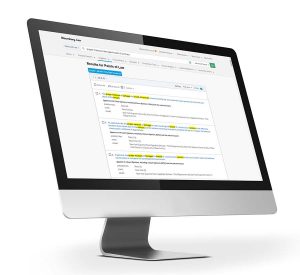
Searching across Points of Law will help to get your bearings on an issue before diving into reading the cases in full. Points of Law uses machine learning to identify key legal principles expressed in court opinions, which are easily searchable by keyword and jurisdiction. This tool helps you quickly find other cases that have expressed the same Point of Law, and directs you to related Points of Law that might be relevant to your research. It is automatically updated with the most recent opinions, saving you time and helping you quickly drill down to the relevant cases.
How do I respond to the opposing side’s brief?
Whether a brief is yours or that of the opposing party, Bloomberg Law’s Brief Analyzer is an essential component in the legal research process. It reduces the time spent analyzing a brief, identifying relevant authorities, and preparing a solid response.
To start, navigate to Brief Analyzer available from the Bloomberg Law homepage, within the Litigation Intelligence Center , or from Docket Key search results for briefs.
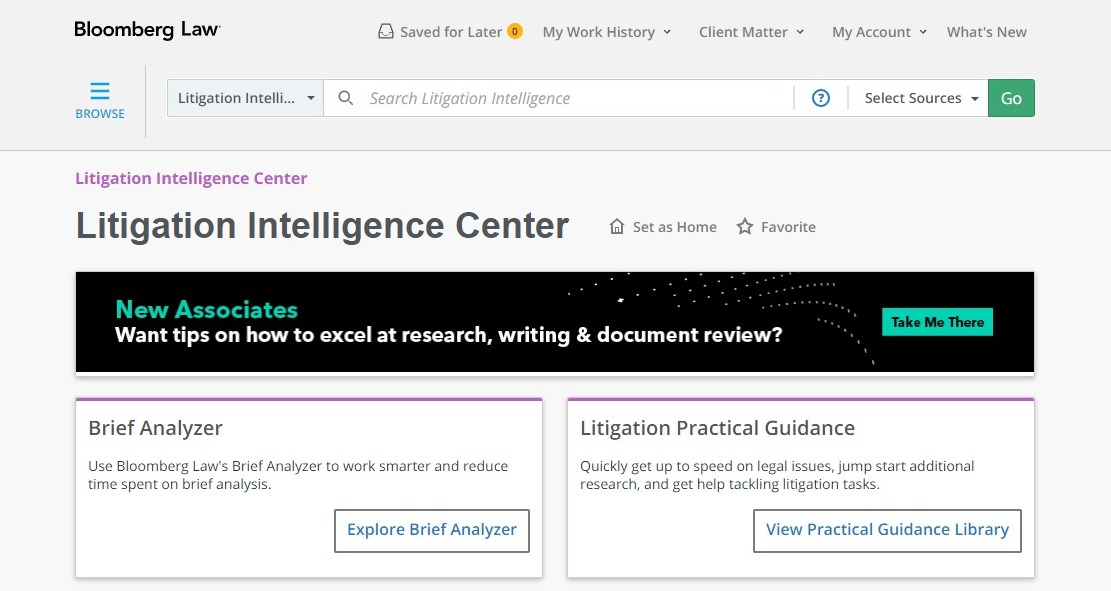
Simply upload the opposing side’s brief into the tool, and Brief Analyzer will generate a report of the cited authorities and arguments contained in the brief.
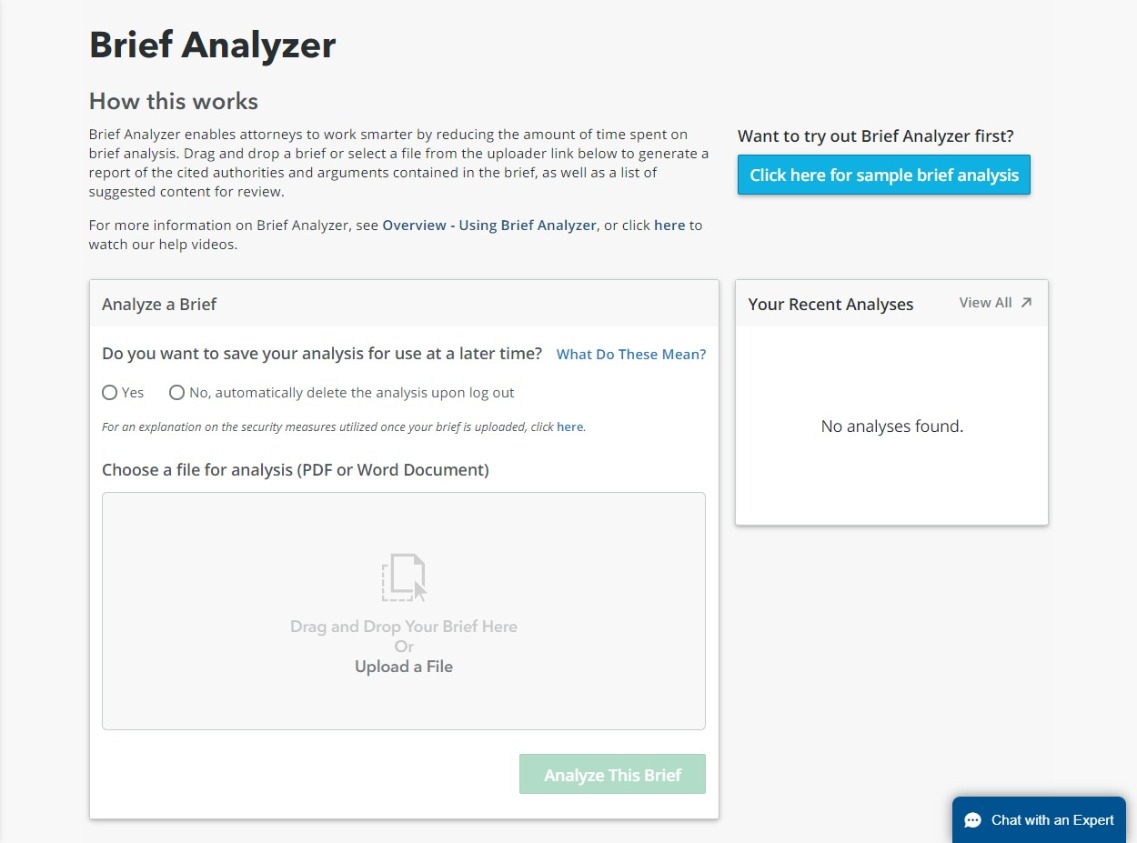
You can easily view a comparison with the brief and analysis side by side. It will also point you directly to relevant cases, Points of Law, and Practical Guidance to jump start your research.
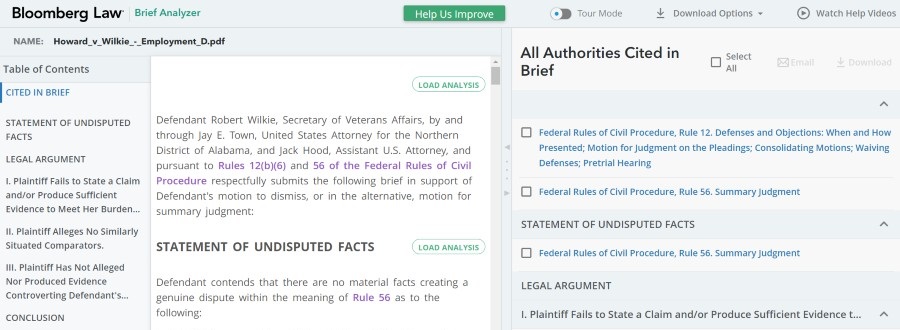
[ How to Write a Legal Brief – Learn how to shorten the legal research cycle and give your legal brief a competitive advantage.]
How to optimize your search.
Crafting searches is a critical skill when it comes to legal research. Although many legal research platforms, including Bloomberg Law, offer natural language searching, terms and connectors (also called Boolean) searching is still a vital legal research skill and should be used when searching across court opinions, dockets, Points of Law, and other primary and secondary sources.
When you conduct a natural language search, the search engine applies algorithms to rank your results. Why a certain case is ranked as it is may not be obvious. This makes it harder to interpret whether the search is giving you everything you need. It is also harder to efficiently and effectively manipulate your search terms to zero in on the results you want. Using Boolean searching gives you better control over your search and greater confidence in your results.
The good news? Bloomberg Law does not charge by the search for court opinion searches. If your initial search was much too broad or much too narrow, you do not have to worry about immediately running a new and improved search.
Follow these tips when beginning a search to ensure that you do not miss relevant materials:
- Make sure you do not have typos in your search string.
- Search the appropriate source or section of the research platform. It is possible to search only within a practice area, jurisdiction, secondary resource, or other grouping of materials.
- Make sure you know which terms and connectors are utilized by the platform you are working on and what they mean – there is no uniform standard set of terms of connectors utilized by all platforms.
- Include in your search all possible terms the court might use, or alternate ways the court may address an issue. It is best to group the alternatives together within a parenthetical, connected by OR between each term.
- Consider including single and multiple character wildcards when relevant. Using a single character wildcard (an asterisk) and/or a multiple character wildcard (an exclamation point) helps you capture all word variations – even those you might not have envisioned.
- Try using a tool that helps you find additional relevant case law. When you find relevant authority, use BCITE on Bloomberg Law to find all other cases and/or sources that cite back to that case. When in BCITE, click on the Citing Documents tab, and search by keyword to narrow the results. Alternatively, you can use the court’s language or ruling to search Points of Law and find other cases that addressed the same issue or reached the same ruling.
[Bloomberg Law subscribers can access a complete checklist of search term best practices . Not a subscriber? Request a Demo .]
How can legal research help with drafting or strategy?
Before drafting a motion or brief, search for examples of what firm lawyers filed with the court in similar cases. You can likely find recent examples in your firm’s internal document system or search Bloomberg Law’s dockets. If possible, look for things filed before the same judge so you can get a quick check on rules/procedures to be followed (and by the same partner when possible so you can get an idea of their style preferences).
Careful docket search provides a wealth of information about relevant cases, jurisdictions, judges, and opposing counsel. On Bloomberg Law, type “Dockets Search” in the Go bar or find the dockets search box in the Litigation Intelligence Center .
If you do not know the specific docket number and/or court, use the docket search functionality Docket Key . Select from any of 20 categories, including motions, briefs, and orders, across all 94 federal district courts, to pinpoint the exact filing of choice.
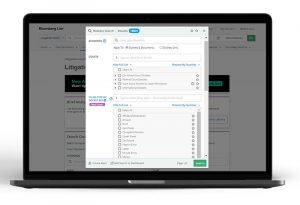
Dockets can also help you access lots of information to guide your case strategy. For example, if you are considering filing a particular type of motion, such as a sanctions motion, you can use dockets to help determine how frequently your judge grants sanctions motions. You can also use dockets to see how similar cases before your judge proceeded through discovery.
If you are researching expert witnesses, you can use dockets to help determine if the expert has been recently excluded from a case, or whether their opinion has been limited. If so, this will help you determine whether the expert is a good fit for your case.
Dockets are a powerful research tool that allow you to search across filings to support your argument. Stay apprised of docket updates with the “Create Alert” option on Bloomberg Law.
Dive deeper into competitive research.
For even more competitive research insights, dive into Bloomberg Law’s Litigation Analytics – this is available in the Litigation tab on the homepage. Data here helps attorneys develop litigation strategy, predict possible outcomes, and better advise clients.
To start, under Litigation Analytics , leverage the Attorney tab to view case history and preview legal strategies the opposition may practice against you. Also, within Litigation Analytics, use the Court tab to get aggregate motion and appeal outcome rates across all federal courts, with the option to run comparisons across jurisdictions, and filter by company, law firm, and attorney.
Use the Judge tab to glean insights from cited opinions, and past and current decisions by motion and appeal outcomes. Also view litigation analytics in the right rail of court opinions.
Docket search can also offer intel on your opponent. Has your opponent filed similar lawsuits or made similar arguments before? How did those cases pan out? You can learn a lot about an opponent from past appearances in court.
How do I validate case law citations?
Checking the status of case law is essential in legal research. Rely on Bloomberg Law’s proprietary citator, BCITE. This time-saving tool lets you know if a case is still good law.
Under each court opinion, simply look to the right rail. There, you will see a thumbnail icon for “BCITE Analysis.” Click on the icon, and you will be provided quick links to direct history (opinions that affect or are affected by the outcome of the case at issue); case analysis (citing cases, with filter and search options), table of authorities, and citing documents.
How should I use technology to improve my legal research?
A significant benefit of digital research platforms and analytics is increased efficiency. Modern legal research technology helps attorneys sift through thousands of cases quickly and comprehensively. These products can also help aggregate or summarize data in a way that is more useful and make associations instantaneously.
For example, before litigation analytics were common, a partner may have asked a junior associate to find all summary judgment motions ruled on by a specific judge to determine how often that judge grants or denies them. The attorney could have done so by manually searching over PACER and/or by searching through court opinions, but that would take a long time. Now, Litigation Analytics can aggregate that data and provide an answer in seconds. Understanding that such products exist can be a game changer. Automating parts of the research process frees up time and effort for other activities that benefit the client and makes legal research and writing more efficient.
[Read our article: Six ways legal technology aids your litigation workflow .]
Tools like Points of Law , dockets and Brief Analyzer can also increase efficiency, especially when narrowing your research to confirm that you found everything on point. In the past, attorneys had to spend many hours (and lots of money) running multiple court opinion searches to ensure they did not miss a case on point. Now, there are tools that can dramatically speed up that process. For example, running a search over Points of Law can immediately direct you to other cases that discuss that same legal principle.
However, it’s important to remember that digital research and analytical tools should be seen as enhancing the legal research experience, not displacing the review, analysis, and judgment of an attorney. An attorney uses his or her knowledge of their client, the facts, the precedent, expert opinions, and his or her own experiences to predict the likely result in a given matter. Digital research products enhance this process by providing more data on a wider array of variables so that an attorney can take even more information into consideration.
[Get all your questions answered, request a Bloomberg Law demo , and more.]
Recommended for you
See bloomberg law in action.
From live events to in-depth reports, discover singular thought leadership from Bloomberg Law. Our network of expert analysts is always on the case – so you can make yours. Request a demo to see it for yourself.
- Lexis+ ® UK
- LexisNexis Newsdesk
- LexisSmart Forms
- Tolley Tax Tutor
- TolleyGuidance
- TolleyLibrary
- Tolley Seminars
- Tolley VAT Update
- LexisWebinars
- Legal Research
- Lexis+ ® UK Legal Research
- Halsbury's Laws of England
- All England Law Reports
- Encyclopaedia of Forms and Precedents (EF&P)
- Atkin's Court Forms
- Gore Browne on Companies
- Context Expert Analytics ®
Legal Guidance
- Lexis+ ® UK Practical Guidance
- Practice Notes
- News Analysis
- Legal Drafting
- Lexis ® Create
- Lexis ® Smart Forms
- Lexis ® Smart Precedents
- Company Law Books
- Criminal Law Books
- Wills and Probate Books
- Legal Handbooks
- Family and Welfare Law Books
- Insolvency Books
Tax Research
- Simon’s Taxes
- De Voil Indirect Tax Service
- Tolley Global Mobility: Employment Taxes
- Tolley EU & Global VAT
- Tolley Tax for the Globally Mobile Individual
- Tax Analysts
Tax Guidance
- Corporation Tax
- Employment Tax
- Owner-Managed Businesses
- Personal Tax
- Trusts and Inheritance Tax
- Value Added Tax
Tax Qualifications & CPD
- Tolley Seminars Online
- Tolley Exam Training
- Tolley In-House Training
- General Taxation Books
- Tax Annuals Books
- VAT (Value Added Tax) Books
- International Tax Books
- Tax Set Offers
- LexisNexis Regulatory Compliance
- Nexis Diligence ®
- Visualfiles
- Due Diligence & Compliance
- News and Business Research
- Media Monitoring and Analysis
- Data-as-a-service and APIs
- TV and Media production
- Lexis+ ® Risk & Compliance
- Insurance Solutions
- Fraud and Identity Management
- Financial Crime Compliance
- Customer Data Management
Premium News
Nexis solutions.
- LexisNexis Newsdesk ®
- Nexis Uni ®
- LexisNexis Blog
- Research & Reports
- Bellwether Reports
- LexisNexis Videos
- Our leadership
- Case studies
- Our experts
Work with us
- Why join us
- How we do business
- Inclusion & diversity
Rule of Law
- A definition
- Our mission
Future of Law

The ultimate guide to conducting legal research

We run through three basic steps that will help lawyers conduct effective legal research, showing them how to create research plans, gather effective information, and review that information.
Legal research is defined as the process of identifying and retrieving information to support legal decision-making. It is essential to lawyers at all stages of their legal careers. It helps students to study for exams, graduates to prepare for careers, and seasoned lawyers to find effective case law to back up their motions, support the over-arching narrative of their case, or refute an opposing argument.
Every lawyer, regardless of their position, should practice legal research. The benefits are obvious. Legal research gives you access to the best facts and knowledge, helps you to form coherent arguments and find effective solutions using the latest information, supports the decision-making process, allows you to curate up-to-date and relevant teaching material for students, and much more.
In short, legal research is essential. But the value you gain depends on the way you conduct the research. In this article, we are going to explore the steps lawyers and legal counsel can take to boost productivity and maximise value with legal research, starting with the creation of a research plan.
Creating a research plan
The first step is finding out what you need to find out. If you are trying to identify and understand the facts of a case, for example, start by recording what you know in a case management tool, such as Visualfiles . That will help you develop a course of action, narrowing down the research.
You’ll then need to build on the initial facts. First, identify where you’re planning to search. Lawyers and legal counsel too often rely on free services like Google to find information. Indeed, the LexisNexis 2022 Bellwether report found that a concerning 74% of lawyers use Google for research.
The problem is that Google often provides information that is unreliable and outdated . And that can prove problematic and time-consuming, as lawyers and legal counsel will need to cross-check and fact-check the information they find, ensuring that it is accurate – or finding that it is inaccurate.
A better option is to find a trusted platform. Take the legal tech tool, Lexis+® UK , for example. Lexis+® UK offers quick and accurate answers using practical guidance and provides leading legal content. It allows you to start with a natural language search or question and offers loads of incredible optimisation features that help lawyers quickly sift through primary and secondary sources.

Once you’ve figured out where to search, you will need to work out what to search. You might want to start by asking yourself questions, such as: What are the main issues that arose when gathering initial facts? What’s the most helpful case law or practical guidance on those issues? Are there any significant gaps in my knowledge? And so on. The answers will define the start of your legal research.
Gather the best information
The next step in the process is to gather all the best information to help you meet your objective. For lawyers working on cases, that usually means gathering relevant sources of law. You should start with secondary law materials , which will help ensure you are up to date on what the experts have to say about a particular topic before you start the (slightly more laborious) task of reading primary sources.
Secondary sources are vital – and one of the massive benefits of legal research tools . Secondary sources include, among other things, practice guides, legal treatises, legal guidance, review articles, journals, legal news, legal dictionaries and encyclopaedias, and some more obscure resources.
Secondary legal sources are, simply put, educational materials that describe or interpret the law. Students can read them to understand how lawyers might analyse a particular case. Lawyers can use secondary sources to build a case. Teachers can use them to show students about the merits of a case.
Then you will need to look at primary legal sources. These are formal documents officially issues by the body that establishes law. They are, in short, the law. Primary sources include , among other things, case law provided by the courts, legislation passed by parliament, tribunals and statutes, court records and court decisions, government documents, and other elements issued by official bodies.
Studying primary sources is the most authoritative act of research, but often time consuming, as the documents can be challenging to read, particularly for students and graduates early in their careers. But you can use secondary sources to make more sense of the primary sources, cross-referencing and cross-checking, exploring interpretations and analysis to simplify the act of research.
Once you’ve checked out the secondary and primary sources, you should have built a strong portfolio of information. At that stage, the legal research process is nearly complete. You’ll just need to review.
Review your information
The final step is the quickest one. It is mainly about practicing caution and ensuring you adopt a thorough approach. You just need to ensure that the legal sector broadly considers the information you have gathered reliable. You may want to double-check, for example, that case law has not been overturned or questioned. Or you may want to check the information you have gathered is up to date.
The above is an easy task, especially if you are using legal research software . Legal software often offers a quick and easy option to view how cases have been treated in court, for example, or view analysis of legal developments, allowing you to double-check information with the click of a button.
Try LexisNexis for free for 7 days
* denotes a required field
Related Articles:

Latest Articles:

About the author:

0330 161 1234
- International Sales(Includes Middle East)
- Latin America and the Caribbean
- Netherlands
- New Zealand
- Philippines
- South Africa
- Switzerland
- United States
Popular Links
- Supplier Payment Terms
- Partner Alliance Programme
HELP & SUPPORT
- Legal Help and Support
- Tolley Tax Help and Support
LEGAL SOLUTIONS
- Compliance and Risk
- Forms and Documents
- Magazines and Journals
- News and Media Analysis
- Practice Management
- Privacy Policy
- Manage Your Cookie Policy
- Terms & Conditions
- Data Protection Inquiry
- Protecting Human Rights: Our Modern Slavery Agreement

- Our students
- Our faculty
- Our community
- Our academic programs
- Our reputation
- Our leadership

- Faculty & Research
- Find a faculty member
- Scholarship repository
- Faculty blog
- Faculty resources

- Areas of Study
- Degree programs
- Curriculum roadmaps
- Experiential learning
- Areas of Concentration
Quick Links

- Your Future
- Career-planning services
- Employment statistics
- Contact the Office of Career and Professional Development
- Employer Services

- Admissions Information
- Admitted Students
- Apply to UF Law
- Entering class profile
- Costs and Financial Aid
- Admissions blog
- Application status
- Visiting UF Law
- Contact Admissions
- LL.M. and S.J.D. Admissions
- Levin College of Law
- ABA Required Disclosures
- Alumni Network
- Diversity at UF Law
- Prospective Students
- Legal Scholars
- Current Students
- Faculty & Research
- Student Life
Lawton Chiles Legal Information Center
Today's hours.

Conducting Legal Research
- Five Step Legal Research Process
- Major Secondary Sources
- Major Primary Sources
- Using Shepard's Citator in Lexis
- Using KeyCite's Citator in Westlaw
- Using Headnotes in Westlaw
- Using Headnotes in Lexis
- Finding Aids
- Additional Research Resources
- Free Sources of Law Online
- Research Tips
Five Steps of Legal Research
This five-step research process can be applied to almost any research project, but it’s important to remember that it is not a rigid formula. Be flexible. Sometimes you will get to step three and realize you should go back and revise your research plan. Other times you might have some preliminary knowledge, so you can start with step two or three. Sometimes, it's easier to do Steps 3 and 4(a) together.
Ultimately, the five steps provide structure for your research and can help you when you don’t know where to go next.
Here are the five steps:
1. Formulate a Research Plan 2. Consult Secondary Sources 3. Consult Primary Sources 4. (a) Expand Primary Law, and (b) Update Primary Law 5. Analyze & Organize Results
The Five Steps
Step One: Formulate a Research Plan
Consider the following preliminary questions:
- Legal question(s) that you need to answer
- Parties & the relationship between the parties
- Area(s) of law
- Jurisdiction
- Most relevant facts
- Legal terms of art
Generate search terms before you begin your research. This will help you to:
- Navigate indexes and tables of contents, and conduct keyword searches; and
- Create both natural language and terms and connectors search terms.
You may not be able to answer every preliminary question and that's okay. Part of the research process is identifying known and unknown information. Answer what you can, then move to Step 2.
Step Two: Consult Secondary Sources
Depending on your familiarity with a particular area of law, you will consult different types of secondary sources.
If you are unfamiliar with an area of law, consult General Secondary Sources such as:
- Legal Encyclopedias, either state-specific, e.g., Florida Jurisprudence 2d (FlaJur); or national, e.g., American Jurisprudence 2d (AmJur) or Corpus Juris Secundum (CJS)
- American Law Reports (ALR)
- General law journals (e.g., Florida Law Review )
If you are familiar with an area of law, consult Subject-specific Secondary Sources such as:
- Treatises focused on a discrete area of law (e.g., Wharton’s Criminal Law )
- Restatements (e.g., Restatement (Second) of the Law of Torts )
- Subject-specific law journals (e.g., Florida Journal of International Law or Harvard Environmental Law Review )
As you develop your knowledge of a particular area, subject-specific secondary sources become more useful.
Step Three: Consult Primary Sources
The secondary sources you consulted in Step 2 should lead you directly to primary sources via references and footnotes.
Once you find relevant primary sources, those primary sources should lead you to other relevant primary sources:
- Annotated codes and regulations lead you to case law, other code sections, and secondary sources.
- Cases lead you to authorities they rely upon – statutes, regulations, and other cases.
Step Four: Expand & Update Primary Law
Step Four has two parts: (a) expanding your research, and (b) updating the primary law that you’ve found to ensure that the law is still good law. Both parts rely on Shepard’s and/or KeyCite.
(a) Expand your research by looking at the cases that a case you've found cites to or that cite to that case; by exploring relevant headnotes in the cases you’ve already found to find other cases that cite to that case for the law in that headnote; or by using the Topic or Key Number system to find additional cases indexed under the same topic as a relevant case.
(b) Update your research (using either Shepard’s or KeyCite) to make sure that the cases, statutes, and regulations you plan to use in your argument haven’t been overruled or otherwise treated negatively; and to determine whether there is more recent case law that discusses the same issue.
Step Five: Analyze & Organize Results
In Step 5, analyze your research and, by extension, any arguments and drafts that you have started to write. Focus on the following:
- Yes = return to research
- No = move forward
- Yes = move forward
- No = return to research
If you need to return to research, go back to Steps One and Two.
- Try a different jurisdiction to see if there are synonyms for the terms you have used.
- Try natural language searches instead of terms and connectors (or vice versa).
- Try to find a subject-specific source (treatise, journal article).
- Use different finding methods to identify secondary sources (indexes, tables of contents, annotated codes).
- Next: Major Secondary Sources >>
- Last Updated: Apr 18, 2023 4:07 PM
- URL: https://guides.law.ufl.edu/legalresearch
University of Florida Levin College of Law 309 Village Drive PO Box 117620 Gainesville, FL 32611 (352) 273-0804 Text-Only Version
- ELEARNING PORTAL
- CONSUMER INFORMATION (ABA REQUIRED DISCLOSURES)
- Diversity Statement
- CONTACT UF LAW
- DISABILITY SERVICES
- REGULATIONS
- PRIVACY POLICY
- Media Inquiries
- Technology Services
- FACULTY DIRECTORY
- CURRENT STUDENTSs
- PUBLIC NOTICES
- WEB UPDATES AND FEEDBACK
- REPORT A CAMPUS/FACILITY CONCERN
- EVENT PLANNING
- Smokeball Legal Community
- CLEs, Webinars & Events
- E-Books, Guides & Case Studies
- Smokeball ROI Calculator
- Hacking Law Firm Success
- Why Smokeball
- Referral Program
- Diversity and Inclusion
Client Login
Legal Research 101: A Step-by-Step Guide
Legal Tech Stack

Rebecca Spiegel
March 20, 2023

Legal research is crucial for lawyers, paralegals, and law students. And it can be a struggle for even the most experienced legal professionals—but it can be overwhelming for beginners.
In this blog post, we’ll cover the basics of legal research, including primary and secondary sources, case law, statutes, regulations, and more. Whether just starting your legal career or looking to refresh your knowledge, this guide will provide a solid foundation for effective legal research. Let’s dive in!
What is legal research?
Legal research is the process of identifying and analyzing legal information to support a legal argument or decision. It involves searching for and analyzing primary and secondary sources, such as case law, statutes, regulations, legal dictionaries, treatises, and law review articles.
There are many reasons you might conduct legal research, including:
- Looking for case law that backs up your motion or brief
- Identifying case law that refutes an opposing argument
- Supporting the general narrative of your case
- Providing legal counsel to clients
- Putting together a memo or brief for law school
Effective legal research can make all the difference in the success of a legal case or argument. Legal research is essential for lawyers, judges, law students, paralegals, and anyone involved in the legal industry. It requires critical thinking, analytical skills, and attention to detail to ensure that legal information is accurate, relevant, and up to date.
How to do legal research
Legal research can be overwhelming and takes many forms depending on your goals. Here are some general steps you’ll likely take in any given legal research project.
Step 1: Gather and understand the key facts of your legal case
A solid legal case starts with strong legal research. So before scouring case laws and court opinions for data, stepping back and setting a few goals is important. What are you hoping to accomplish with this case, and what key facts will support your argument?
Once you understand the information you’re looking for, ask yourself these questions to start your research on the right foot.
Key questions to ask yourself before starting legal research
What are the basics.
Whether working with a client or writing a law brief for school, always start with the basics. What’s the “who, what, why, when, where, and how?”
Write a quick summary, especially since you’ll likely need it for a statement of facts in a filing or legal brief. You never know what facts might be helpful later! Even if details you think may not be relevant now, include them on your list.
Pro tip: Record your essential facts in a case management tool . While it may be tempting to skip this step, a case management tool will help you streamline your legal process, reduce human error, and save you time in the long run as you juggle multiple clients.
What's the legal issue?
Next, identify the actual legal issue you’re hoping to solve. Does your client need help to settle a property ownership dispute? Or are they pursuing worker’s compensation for an accident that happened on the clock?
No matter the legal research project, having a clear sense of the legal problem is crucial to determining your desired outcome. A clear end goal will help you stay focused and on topic throughout your casework.
What jurisdiction are you operating in?
When it comes to legal research, casting a wide net can be a bad thing. There are endless amounts of court opinions and legal databases that you could sort through. But your research will have been for naught if they’re irrelevant to your case.
That’s why it’s necessary to identify the relevant jurisdiction for your case. Does it deal with federal or state law? If a state, which one? You might find applicable case law from a Washington state supreme court that supports your argument, but it won’t hold up with opposing counsel if you’re operating in Montana.
Create a research plan
Now, it’s time to think about where you’ll go to perform legal research. While Google might be a good start for some of the basic facts you need, it’s probably not enough. Legal encyclopedias and law journals have traditionally supported lawyers as they’ve conducted research, but technology has also made the process a lot easier now. Law firms might invest in an online legal research service to comb through relevant statutes legal topics.
Step 2: Gather sources of law
The next step as you conduct legal research is to gather relevant law sources.
There are two different kinds of sources: primary law and secondary law. As you start your research, it's important to note that you should start with secondary law materials.
Why? Because these sources will help you understand what experts have to say about a legal topic before you start your case and investigate primary materials. Think of it as building a knowledgeable foundation for your argument: you'll sound smarter (and win your case) if you know what experts are saying about the legal topic you're researching.
What are secondary legal sources?
Secondary legal sources are publications that analyze, interpret, or explain primary legal sources. They are not the law itself, but rather resources that provide commentary, context, or background information on the law. Examples of secondary legal sources include:
- legal encyclopedias and dictionaries
- law review articles
- legal treatises
- practice guides
- annotated codes
- Law journals
- Legal news
- Jury instructions
Secondary sources can be helpful for several reasons, including providing a deeper understanding of legal concepts, identifying key issues and arguments, and finding additional primary sources. They can also help determine the law's current state and identify any changes or developments in legal trends or interpretations.
It is important to note that secondary legal sources are not authoritative sources of law and should not be relied upon as legal precedent. Instead, they can be used to support and supplement primary legal sources in legal research and analysis.
What are primary legal sources?
Primary legal sources establish legal rules and principles. The existing laws, regulations, and judicial decisions create, interpret, and enforce legal principles and rules. Examples of primary legal sources include:
- Statutes: Written laws enacted by legislative bodies at the federal, state, or local level.
- Case law: Decisions made by courts in the course of resolving disputes.
- Regulations: Rules and standards issued by administrative agencies to implement and interpret statutes.
- Constitutions: Written documents that establish the basic principles and structure of a government.
Primary legal sources are considered the most authoritative sources of law and are relied upon to determine legal rights and obligations. They are often used in legal research and analysis to interpret and apply the law to specific cases or situations. It is important to note that primary legal sources can be complex and require careful analysis and interpretation to determine their meaning and scope.
Step 3: Make sure you’re using “good” law
Another important step in the legal research process is to verify that any cases and statutes you use are still "good law" — in other words, that they're still valid and relevant. Overruled or unconstitutional statutes won't help you win any cases.
Can older cases still be considered "good?"
Whenever possible, it's a good idea to use the most recent cases possible. They're more likely to be relevant to your case and are less likely to have been rendered obsolete. That said, recency isn't mandatory.
A case that's 30 years old could still be considered "good law" if it hasn't been overruled or otherwise made irrelevant. If it fits with the facts of your case and falls within your jurisdiction, it could still be helpful for your argument!
Use a citator
A citator can help you check to see if your research contains "good" law. Citators verify legal authority by providing the history and precedent for any cases, statutes, and legal sources you use.
Most legal databases have their own citator tools, which flag negative materials and can help you evaluate whether a case is "good" law. Citator tools can also help you find other relevant cases that cite the opinion in question.
Step 4: Sum up results and look for gaps
Once your initial legal research process is complete, compile it into a legal memorandum. This will help you identify any gaps in the facts you've collected and anticipate any additional information you might need.
A good legal memorandum:
- States the facts of the case
- Identifies the issue
- Applies “good” law to the facts
- Predicts any counterpoints
- Assesses the outcome of the case
The best tips and strategies for conducting legal research
Conducting legal research can be a challenging task, requiring both expertise and a strategic approach. Here are our best tips and strategies for conducting effective legal research, to help you to navigate the complexities of the legal system with confidence.
Think about the opposing counsel’s arguments
Consider your case from all angles. What will your opposition's arguments look like? Think competitively as you perform legal research, and search for facts that will refute any legal basis the opposing party may claim.
Don't stop researching
Your research isn't over until your assignment is submitted or your case is closed. Don't cut corners and use all of the time you have available to you. You never know when you're going to find a vital piece of research that could positively impact your case.
Take advantage of legal research tools
In recent years, legal research technology has transformed the way lawyers and legal professionals conduct research. With the help of advanced search algorithms, machine learning, and natural language processing, legal research technology can help to streamline the research process, increase efficiency, and provide more accurate and comprehensive results.
Here are a few tools that help streamline the legal research process:
- ROSS Intelligence is a legal research platform that's driven by AI. ROSS lets you highlight statements in your memorandums and briefs to instantly search for cases and statutes that cover similar laws. You can also use ROSS to look for negative case treatment in your pleadings and law briefs.
- Casetext’s CARA AI search technology and automated review tools help lawyers speed up their legal searches. You can use Casetext to start your research with a complaint or legal brief, and find highly relevant, tailored search results and resources. Not only does Casetext find facts and legal issues, but it will filter results to the jurisdiction you're looking for. Casetext’s citator also makes it easier to check and flag any bad law.
Document your research with law practice management software
A poor documentation system can ruin your entire legal research process. Law practice management software can help you record your research in an efficient, streamlined, and automated way—so that no detail ever falls through the cracks.
Smokeball's legal case management software keeps your entire law firm organized by helping you collect details during client intake, saving them to the correct case matter and auto-populating the documents you need with the correct information. And our Client Portal helps you communicate with clients, request more details when you need it, and share research results.
Download Now: Getting Automated: An End-to-End Guide to Law Firm Automation
In conclusion, legal research is an essential skill for lawyers, law students, and other legal professionals. By mastering the basics of legal research, including identifying primary and secondary legal sources, using legal research tools effectively, and developing a strategic approach to research, legal professionals can improve the quality of their work and provide better outcomes for their clients.
With the help of Smokeball's legal practice management software, legal research can become a more efficient, and effective process. We're here to support your law firm from the initial research stage to client communication to i nvoicing and billing when your case is closed.
FAQs about legal research
What is shepardizing in legal research.
Shepardizing is a process used in legal research to determine whether a particular case or statute is still good law. It involves checking the history and subsequent treatment of the case or statute to ensure that it has not been overruled, superseded, or otherwise invalidated. Shepardizing is an important step in legal research to ensure the accuracy and relevance of the sources being used.
Can I use Google for legal research?
Yes, Google can be a great first step to find basic details for your case. Google Scholar is also a good resource for lawyers conducting legal research. It contains an extensive database of state and federal cases, with superior search functionality.
However, Google is clear that the resources they provide are not vetted or approved by a legal professional:
“Legal opinions in Google Scholar are provided for informational purposes only and should not be relied on as a substitute for legal advice from a licensed lawyer. Google™ does not warrant that the information is complete or accurate.”
So it's important to verify that any of the sources you pull from Google Scholar are accurate, and are considered "good" law.
How to do legal research as a paralegal?
A good paralegal will follow the steps of D.I.S.P.U.T.E . to define the legal issues of the case and find relevant case law.
- D id you identify all of the relevant parties involved in the case?
- I s the location important?
- S ome items or objects may be important to the case.
- P ut the events in chronological order.
- U nderstanding the events will give you the basis of action or the issues that are involved in the case.
- T ake into consideration the opposing counsel’s arguments in the case.
- E valuate the legal remedy or the relief sought in the case.
Building Your Legal Tech Stack: A Legal Technology Starter Guide
Learn more about smokeball.
- Schedule your personalized demo
- Get your free trial of Smokeball Start
- Explore our features
- Meet our team
- View pricing
Related Product Content
Learn more about smokeball document management for law firms, book your free demo.
Ready to see how Smokeball client intake software helps you Run Your Best Firm? Schedule your free demo!
This field is required.
Your personal data will be kept confidential. For more information about how we collect, store, and use your personal data, please read our Privacy Policy and Terms and Conditions .
Share this legal blog on social media.

Director of Content & Social
More from the Smokeball blog

Apply for Smokeball’s community hero award
Nominations are now open for Smokeball’s prestigious Beacon Award. This honor recognizes legal professionals making a significant impact on their clients and communities through pro bono work, legal services, and more.

Artificial Intelligence
AI in Law Firms: 4 Game Changing Examples to Boost Your Productivity Now
Imagine a future where your best lawyers are freed up for strategy and creativity instead of getting bogged down by tedious tasks. Welcome to the age of AI in law firms.
.png)
Billable Hours: Understanding How Law Firms Bill
The billable hour is like the golden calf for many law firms and attorneys — all worship it, but many don’t understand what it means or how law firms really a bill.
Subscribe to Our Newsletter
Get regular updates, webinar invites and helpful content, delivered directly to your inbox!

Law School Home
Getting Started With Legal Research: Strategy and Considerations
- Strategy and Considerations
- Types of Resources
- Finding Legal Resources
Beginning legal research can be daunting task. Below are some strategic guidelines for starting your research and considerations to keep in mind.
For deeper insight into legal research, you will find the books highlighted below in the MLaw collection.
Step One: Plan Your Research
- Frame the legal issues and consider the facts
- Determine the applicable jurisdiction
- Generate initial keywords for search terms
Step Two: Consult Secondary Sources
- For an overview of your topic, search Google or Wikipedia or consult a legal dictionary
- Refine search terms using new knowledge
- Use more specific secondary authority as you narrow your search
- Discover what primary authority is cited by the secondary sources
Step Three: Search for Primary Authorities
- Consult statutes, regulations, and case law
- Search for primary authorities mentioned by secondary sources and other primary sources
Step Four: Expand and Update Case Research
- Evaluate how cases relate to earlier relevant cases
- Find references to relevant cases with key numbers
- Make sure cases are still good law by using a citator
Step Five: Analyze and Organize Results
- Determine what primary authorities are actually relevant to your facts
- Determine what primary authorities are binding on your issue
See Mark K. Osbeck, Impeccable Research: A Concise Guide to Mastering Legal Research Skills, 2nd (2016).
Guides on Legal Research and the Legal System
- Locating the Law: A Handbook for Non-Law Librarians (6th) Ed. Elizabeth Caulfield 2018 publication of Southern California Association of Law Libraries Also available on their website https://scallnet.org/publications/ .
Keep these factors in mind when conducting research online.
Primary Sources Primary materials are more likely to be available online than secondary materials. The U.S. federal government has especially made a point of trying to make official documents available online. It is also less expensive to publish electronically, so many governments are moving toward online-only government publication policy.
Secondary Sources Secondary sources are less likely to be online (for copyright, use, and cost issues). However, many law journals are now published in both print and electronic formats.
Coverage Dates With the exception of archival projects, most legal information on the internet is available beginning in the mid-1990s.
Citators There are no free citators for ensuring that a law is still good. Patrons on the U-M campus can access Shepard's Citator on Nexis Uni .
Depth of Research Free internet resources are likely the fastest (or only) option when looking for a single document or statistic. These resources are not as useful for in-depth legal research, such as looking for the ten best cases on your subject or making sure your case is still good law.
Research Guides Research guides will often list useful print and Internet resources for legal research on a given subject. They can been a good starting point for legal research on an unfamiliar subject. Online research guides are generally free and most major law school libraries have collections of research guides on their websites. Remember that local and regional law libraries may have research guides on state-specific legal research. Search online for "[subject] libguide" or "[subject] research guide" to find useful sources.
Library Catalogs Many law libraries now add links to Internet materials in their online catalogs. Searching a library's catalog is more exact than searching the Internet because libraries use standardized subject headings and uniform names that do not vary within a particular catalog or between catalogs. Library catalogs are also helpful because the librarians have already looked at resources and then made the decision to select that resource for their collection. Accordingly, the Internet resources linked in library catalogs will often be official or useful or both.
- Next: Types of Resources >>
- Last Updated: Apr 9, 2024 11:39 AM
- URL: https://libguides.law.umich.edu/getting-started
Copyright © Regents of University of Michigan
How to Do Legal Research: The Ultimate Overview
By The MyCase Team
Sep 25, 2023

Whether you’re brand new to practicing law or a seasoned pro, effective legal research is one of the cornerstones of being a successful lawyer. Throughout your career, legal research skills can help you stay abreast of evolving precedent.
However, it’s not just the law itself that’s changing but many of the methods for conducting legal research have transformed in the digital age. These days, crafting a perfect legal argument takes a winning combination of experience, intuition, and the ability to leverage technology.
To make sure you’re getting the most from your legal research, we’ve put together a guide that covers the basic steps of effective legal research and the latest tools and best practices at your disposal.
What is Legal Research?
Legal research is the process of finding relevant laws, case summaries, and other information to back up your legal arguments and decision making. In addition to preparing for a filing or trial, an attorney may do legal research to accurately answer a client’s questions and provide guidance.
Specific laws and decisions also are subject to change over time. So while doing research, legal experts must also make sure they’re using “good” law–in other words, that the decision or specific case they’re citing is still relevant.
Why is Effective Legal Research Important?

Without a solid foundation of quality legal research, it can be difficult to know if a given argument or precedent is valid or will work. Beyond that, using well-researched arguments backed by the most up-to-date citations will help you:
- Get a complete and accurate picture of the case at hand
- Achieve better outcomes for clients
- Develop smarter and more sophisticated case strategies
- Help you stay up to date on the law and legal trends in your practice area
Additionally, using legal analytics and other digital tools to supplement your research can also help you predict success rates, understand the costs and time of a given case, and work more efficiently overall.
How to Conduct Legal Research in 5 Steps
For many years, a lawyer’s best research tools were largely limited to libraries, books, and physical documents. Now, there is a plethora of available online tools and resources to help. However, even the most sophisticated tools aren’t worth much unless you already have a solid understanding of how to conduct legal research..
Regardless of what you use to research, there are several basic steps that go into effective legal research:
1. Gather the Facts
Before building an argument, you need to understand the exact nature of the issue you’re faced with. The initial fact-finding process helps you determine:
- What is the jurisdiction?
- Is it a federal or state issue?
- A reasonable goal/desired outcome to expect
- The facts of the case: who, what, where, when, how
By answering these initial questions, you can then narrow your search to be more specific. Many legal experts use case management software to assist with tracking client and case information right from the intake stage. Software will also make it easier when locating or attaching relevant documents in the future as well.
2. Create a Research Plan
Using the facts you’ve already gathered, you’ll then determine what primary sources and case law will be most relevant to your case. Instead of diving straight into the research, it can be extremely helpful to develop a research plan first.
At this stage, it’s less important to know exactly what sources you’re looking for and more about creating a list of relevant legal terms and what filters you should apply (more on that later). You do this by analyzing the facts of the case, assessing what you still need to learn, and creating a list of potential search terms.
3. Gather Sources
Armed with a list of relevant terms and facts about your case, it’s time to get into law research. You’ll generally find two types of sources valuable.
Primary Sources: Primary legal sources are formal documents issued by a state or federal government that establish law such as:
- Court decisions
- Regulations
- Constitutions
Secondary Sources : Secondary sources provide summaries of legal matters and court decisions. Some examples of secondary sources include:
- Legal articles
- Practice guides
- Legal dictionaries
Ultimately, the most important citations you can provide will be primary legal sources—but often the fastest route to finding them is by mining secondary sources that point you in the right direction. It also lets you see what other legal experts have said about similar issues, giving you further insights into what direction your strategy and research should take.
While physically going to the library and cracking the books still has its place, technology has made the initial research stages much easier. There are a number of free and paid online resources , like Google Scholar , available for lawyers — which you use depends on your budget, how big your firm is, and what kind of advanced features you’re looking for.
Search tools that incorporate artificial intelligence (AI) let you use natural language or informal search terms to find relevant documents, significantly accelerating the research process. AI can also be used to provide succinct summaries of lengthy documents like cases, laws, deposition transcripts, and more.
4. Ensure That You’re Using “Good” Law
As we touched on briefly before, it’s vital to make sure you’re using “good” law. What is “good” law? Basically, it’s making sure a legal decision, case, or other source you’re using is in good standing with the courts and still relevant. A perfect example from a ruling might seem great at first until you find out the decision was overturned at a later date, appealed, or made obsolete by a new law.
A good rule of thumb is to try and find recent cases as they are more likely to still be relevant. Of course, that doesn’t mean old cases should be avoided outright.
Using a citator—a legal tool that cross references your document with other citations—is vital to ensuring the document you’re using doesn’t have any negative history. Many newer citators will also provide a summary of the findings and point you towards similar cases.
In addition to looking only for negative history (like decisions that were overturned), it’s also important to note differentiators or unique factors that contributed to one outcome or another. This is another area where legal analytics and AI can shine, helping you understand meaningful patterns in case law.
5. Check Your Work
The legal research process can get intense, and sometimes it’s easy to get lost in the details. Before finalizing, it’s a good idea to summarize your findings to show how your full body of research supports your desired conclusion. This is also called a legal memorandum, and while it might seem redundant, a legal memo can be useful for:
- Fostering internal collaboration within your law firm
- Communicating strategy with your clients
- Documenting your legal processes and findings
Tips to Improve Your Legal Research Skills

With a solid foundation of basic legal research skills you can take advantage of the latest best practices and tools to make your law research process even more efficient. When determining how to improve your legal research skills, here are some important starting points.
Use Legal Technology
Effectively representing your clients and drafting winning arguments comes from utilizing every tool at your disposal. Specialized legal software comes with a number of built-in capabilities that streamline legal research and ensure it’s more effective. Supplementing this with the capabilities of leading case management software can help further with things like:
- Custom Workflows : Workflows can be set up based on the type of case to automate tasks, create deadlines, pull specific documents, and more.
- Case Analytics : Analytics tools provide a 360-degree view of every case that leads to actionable insights. Analytics tools not only help during the research process, but can also be used to better understand your own case history and workflows in order to find areas for improvement or gaps.
- Time Tracking and Scheduling : Case management can make it easier to track the time you spend on research and other tasks. Not only does this make tracking billable hours easier, it allows you to stay on top of important deadlines which is vital when handling multiple cases at once.
- Document Management : Keep all relevant case files in one place with comprehensive document management tools. Software like MyCase ensures all of your documents are organized, accessible, and secure—bolstering collaboration and helping to establish a single source of truth.
Leverage AI to Check Your Work
The topic of AI has exploded within the last year and generated a lot of excitement. When you look at its capabilities within the legal field, it’s easy to understand why. There are already several tools out there that help speed up research without losing quality or accuracy.
AI tools can help check your work by summarizing your sources, pointing you towards others, and checking for anything you’ve missed. While many traditional online searches get stuck when you fail to use the exact right wording, AI helps get around this by generating tailored search results based on plain language.
Boost Your Legal Research Efficiency With Best-In-Class Technology
Learning how to conduct legal research effectively is crucial for the long term success of any lawyer. Having a solid research process not only helps lawyers achieve better outcomes for their clients, but allows them to use their time more efficiently.
Leading law firms across the country rely on MyCase to help centralize their documentation, client communication, calendaring, and more. Features like full text search , which allows you to instantly search for terms within your digital files, are also crucial for finding relevant documents quickly.
By leveraging a best-in-class case management platform to support their research processes and workflows, law firms can boost efficiency and collaboration like never before.
Sign up for a 10-day free trial or schedule a MyCase demo today to learn more.
Search Resources
For the record newsletter.
Insights on running a successful law firm with case management, client intake, billing and payments, tech innovation, and more.
Related resources

8 Lawyer Skills That Drive Success

Top Criminal Justice Technology for Lawyers

What is a Legal Assistant? Their Roles and Duties Explained
- Support Center
- System Status

A paralegal’s guide on how to do legal research

- April 16, 2024

Laura Krieg

Legal research serves as the cornerstone of informed legal practice, offering the means to navigate a constantly evolving legal landscape.
The importance of effective legal research cannot be overstated in a world where laws multiply, and court decisions shape the foundation of legal arguments.
This blog post will delve into the essence of legal research, explore the sources of law, understand primary versus secondary sources, decipher mandatory versus persuasive authority, and unveil the practical steps of the legal research process.
Join us in unraveling the complexities of legal research, a skill essential for any legal professional striving for success.
What is legal research?
Legal research means finding law that supports a legal argument or decision. The law is always changing, and new laws and court decisions are added each year.
In 2022, California’s Governor Gavin Newsom signed 997 bills into law, and the federal government passed 249 bills . Add to that all the cases published each year, and the amount of information attorneys and paralegals need to know is staggering.
Given this, legal professionals do not know the answer to every legal question and must rely on effective and thorough legal research to identify and find the laws that apply to the facts of the case. Effective legal research is integral to the practice of law.
What are the sources of law?
Efficient legal research starts first with an understanding of the sources of law in the United States.
- Constitutional law: The federal government and all the states have constitutions whose primary purpose is to establish the government and define its functions and obligations in relation to the people.
- Statutory law: Laws established by legislative action.
- Administrative regulations: Administrative agencies (IRS, FDA, FAA, etc.) have the power to make necessary rules and regulations.
- Ordinances: Laws established by a local government such as a county board of supervisors or city council.
- Case law: Laws are created in the form of decisions, also called opinions, that are published in case reporters. Case law is also known as common law and is based on the legal principle known as stare decisis (let the decision stand). Simply put, courts are required to follow earlier decisions made by higher courts, such as the Supreme Court. This helps make the law predictable.
How to do legal research
Knowing how to do legal research in an effective way is a crucial skill for paralegals in the discovery and trial preparation process.
The process of identifying and gathering information relevant to legal questions or issues, involving searching for and analyzing legal sources such as statutes, regulations, case law, and secondary sources like legal commentaries and scholarly articles, is essential to master.
Here’s a step-by-step checklist to conducting legal research:
- Identify the legal issue: Clearly define the legal question or issue you are researching. Understand the key terms and concepts involved.
- Find primary sources: Start by searching for primary sources, which include statutes, regulations, and case law. Use legal databases such as Westlaw, LexisNexis, or public databases like the Legal Information Institute (LII).
- Locate relevant case law: Search for relevant case law using legal databases or court websites. Look for cases that interpret the statutes or regulations relevant to your issue.
- Use secondary sources: Consult secondary sources such as legal commentaries, treatises, and law review articles. These can provide background information, analysis, and citations to primary sources.
- Check jurisdiction: Ensure that your research is relevant to the appropriate jurisdiction, as laws can vary by state, federal, or international levels.
- Update your research: Legal research is a dynamic process. Verify that the cases, statutes, and regulations you find are current and still good law.
- Organize and analyze: Organize your findings and analyze them to form a legal argument or opinion.
How to do legal research as a paralegal
As a paralegal, conducting legal research is of critical importance in supporting attorneys and their cases.
Your role involves assisting in gathering and analyzing legal information, including statutes, regulations, case law, and other legal sources.
Once you’ve followed the steps above, there are a number of elements in the legal research process that must be adhered to.
As a paralegal, legal research must be continued by:
- Analyze information: Compare and contrast legal sources and summarize the findings to help the attorney understand how the legal issue is addressed in the law.
- Prepare research memos: Write detailed research memos summarizing your findings, including citations to cases, statutes, and other sources. The memos should be clear and concise, making it easy for the attorney to understand the legal landscape.
- Stay updated: Keep track of any changes in the law and update your research as needed. Legal research is an ongoing process, and you may need to revisit your findings.
- Work collaboratively: Communicate and collaborate with the attorney and other team members throughout the research process to ensure that your findings align with their needs and goals.
What is the difference between primary sources v. secondary sources?
Primary sources of law are constitutions, statutes, regulations, ordinances, and case law. Primary sources articulate the law.
Secondary sources are plain-language writings by legal scholars that explain, analyze, and criticize primary law. Secondary sources are a great place to start research on any legal topic as they provide an overview of the relevant law. Secondary sources are not the law, they are the author’s interpretation or explanation of the law and are not binding on the courts. Secondary sources explain the law and will cite the relevant case law, statutes, etc.
Secondary sources include:
- Practice guides
- Legal treatises
- Law review articles
- Scholarly journals
- Legal dictionaries and encyclopedias
- Jury instructions
Seeing the difference
As an example of the difference , the U.S. Supreme Court decision of Brown v. Board of Education is a primary legal source, establishing that state laws permitting separate schools for whites and blacks are unconstitutional.
The book “Simple Justice” and the Gale Encyclopedia of American Law provide secondary legal sources, offering discussions and analyses of the case and its historical context.
Similarly, the Fourth Amendment to the U.S. Constitution is primary law, guaranteeing the right to security against unreasonable searches. However, an article from the 2012 William and Mary Law Review analyzing a specific aspect of the Fourth Amendment constitutes a secondary legal source.
What is the difference between mandatory authority v. persuasive authority?
Courts are required to follow the decisions of higher courts in the same jurisdiction. Court cases from a higher court and in the same jurisdiction are considered mandatory authority. All federal and state courts are bound by the decisions of the United States Supreme Court related to the United States Constitution and federal laws. State courts are bound by the decisions of the higher courts in that state, such as the state’s Supreme Court.
If there is little or no mandatory authority in your jurisdiction, you may want to look at cases from other jurisdictions. This is persuasive authority, meaning the court may follow the ruling but is not required to.
What is the legal research process?
The legal research process can seem overwhelming with the volumes of legal resources available. How do you do legal research? The same way you eat an elephant, one bite at a time. Legal research is the elephant, and to successfully complete the research, take it one step (bite) at a time. Knowing the steps to perform legal research makes the process much less daunting.
Step 1: Identify the facts, issues, and jurisdiction
Before you can begin your research, you must first determine the facts, the issues, and the jurisdiction of the legal research project. Eliminate the unimportant facts and focus on the essential facts such as who, what, where, and how. Use the facts to pinpoint the legal issues and to determine the jurisdiction.
Step 2: Find relevant law
It sounds easy enough until you start thinking about the sheer volume of statutes and published case law, and then it can become overwhelming for the researcher.
When I was teaching paralegal students, I always told my students to start with secondary sources.
Even though secondary sources are not the law and are not binding on the courts, secondary sources educate the researcher on the topic and build your knowledge base.
Keep in mind that in order to publish the material, the writer had to go through the legal research process and have identified the primary resources most applicable to the topic.
The secondary source will explain the relevant primary source, such as the governing statutes and case law. Do not rely only on the secondary source. Once you have the applicable statutes, go directly to the primary source.
What are search methods?
To use research databases efficiently, there are several search techniques you can use to improve the precision of your search results.
The more precise your search. The less irrelevant material you will need to review, the more you need to start with a broad search using keywords.
If the search is returning too many results, narrow the search by using connectors.
Search techniques
Some search techniques include (please note this is not a complete list):
- And: Use “and” between your search terms to indicate that all terms must appear in your search results. For example, the search – banana and slip and fall – will retrieve materials containing each of these terms.
- Or: Use “or” between your search terms to indicate that any one of the listed terms appears in your results. This is very helpful when your issue may include synonyms for the same concept. For example, the search – minor or juvenile or child or children or infant – will retrieve materials that have any one of these terms.
- Not: Use “not” to disqualify words from your search. “Not” is a rarely used connector, but it can be helpful under certain circumstances. For example, if you were searching for a particular anti-corruption statute, you may want to run the search – RICO, not “Puerto Rico.”
- Proximity connectors designate how closely your search terms must appear within a document.
Common proximity connectors include:
- /p: Terms must appear in the same paragraph.
- /s: Terms must appear in the same sentence.
- /n: (such as /3) – Terms must appear within the specified number of words to each other.
- Phrases: Using quotation marks (“ ”) allows you to search for a particular phrase. To search for a specific phrase put the phrase in quotation marks. For example, if you were interested in searching for mentions of the television show “Orange is the New Black,” simply run the search “Orange is the New Black.”
Where do I go to conduct the research?
Programs such as Lexis and Westlaw are online subscription legal research programs. The costs for these programs can be prohibitive, especially if you do not conduct legal research on a regular basis.
If you do not have access to these programs, you can still conduct effective legal research using free sources available online.
Use your favorite search engine, such as Google, to locate both secondary (articles written by legal professionals) and primary sources of law.
Reminder: use the secondary source to locate applicable law, and then always go directly to the primary source for your answers.
Step 3: Check to see if you are using good law
Research is not complete until you have checked to make sure the law you found is still valid and relevant. The quickest way to draft a losing document is to rely on a case that has been overruled or a statute deemed unconstitutional. Citators let you verify a case’s authority by listing cases, statutes, and legal sources so you can check that it has not been overruled, questioned, or made irrelevant.
Legal research software such as Lexis and Westlaw makes checking the validity quick and easy. Google Scholar includes ‘How cited,” which is a list of cases that have cited the selected opinion.
Research in practice
Now that we know how to conduct legal research let’s practice. For this scenario, I only used resources that were available for free online.
Sample research scenario
A potential new client (PNC) On November 1, 2023, on a beautiful, crisp fall afternoon, our client Anita Radcliff was walking Fluffy, her beloved shih tzu, on a leash at a public park in California when a large dalmatian ran up to Fluffy and bit her.
Animal control was called, and the Dalmatian’s owner was located. It was determined that the Dalmatian had never bitten another animal or person before this incident.
Anita rushed Fluffy to the vet, and despite all efforts, Fluffy unfortunately died. Fluffy was a registered emotional support animal, and Anita was devastated by her death.
Important facts:
- Fluffy was leashed.
- Dalmatian was unleashed.
- Dalmatian bit Fluffy. This was the Dalmatian’s first bite.
- Fluffy died.
- Fluffy was a registered emotional support animal.
- The owner is devastated.
- Is the owner of the Dalmatian liable for the death of Fluffy?
- What remedies in law (damages) does Anita have?
Jurisdiction:
Now that the facts, issues, and jurisdiction have been determined, it is time to begin your research.
Issue 1: Is the owner of the Dalmatian liable for the death of Fluffy?
Finding the answer to this issue was quick (about one minute).
Search terms – owner liability for dog bites in California – Google came up with about 15,600,000 results. Using (“ ”) did not narrow this search.
I found a helpful article (secondary source) that directed me to California Civil Code section 3342, subdivision (a) (primary source). Based on the Civil Code, the brief answer is “yes,” the Dalmatian’s owner is liable for the death of Fluffy.
Answer: Yes. Based on Civil Code section 3342, the Dalmatian’s owner is liable for the death of Fluffy.
Issue 2: What remedies in law (damages) does Anita have?
Finding the answer to this issue was more involved and took about 20 minutes (this included skimming through the cases), with more research needed.
Search terms – damages for the death of an emotional support animal California law – Google came up with about 15,800,000 results. Using (“ ”) reduced that to about 12,500,000 results.
I didn’t find the first few results very helpful, so I searched a little further down on the first page of my search results and located California Civil Jury Instruction No. 39030 (secondary source). The jury instruction has a section “Directions for Use” and “Sources and Authority.” Both these sections have California case law. They also have a “Secondary Sources” section.
From the jury instruction, I found the cases (primary source) of Martinez v. Robledo (2012) 210 Cal.App.4th 384 and Plotnik v. Meihaus (2012) 208 Cal.App.4th 1590.
Answer: Anita is entitled to recover the value of Fluffy and reasonable vet bills. She may also be entitled to recover punitive damages and damages for emotional distress, but more research would be needed. Note: If I was doing this research for an attorney, I would continue researching for the answers to punitive damages and damages for emotional distress.
Today, we’ve explored the core components of legal research, from sources of law to primary vs. secondary sources, mandatory vs. persuasive authority, and practical research steps.
Although only an attorney can give legal advice and perform particular functions with regard to clients, paralegals oftentimes will conduct the initial research attorneys rely on. Effective legal research can make or break a case and is critical to the practice of law.
Legal research can be hard and daunting due to the sheer volume of laws, but by following a few simple steps, you can eat the research elephant one step (bite) at a time.
We’ve looked at some real-word examples to highlight this process, showcasing the importance of secondary sources and precision in search terms.
Bear this guide in mind when conducting case law in future, and stay efficient in your research!
A free, detailed guide on all the basics of eFiling
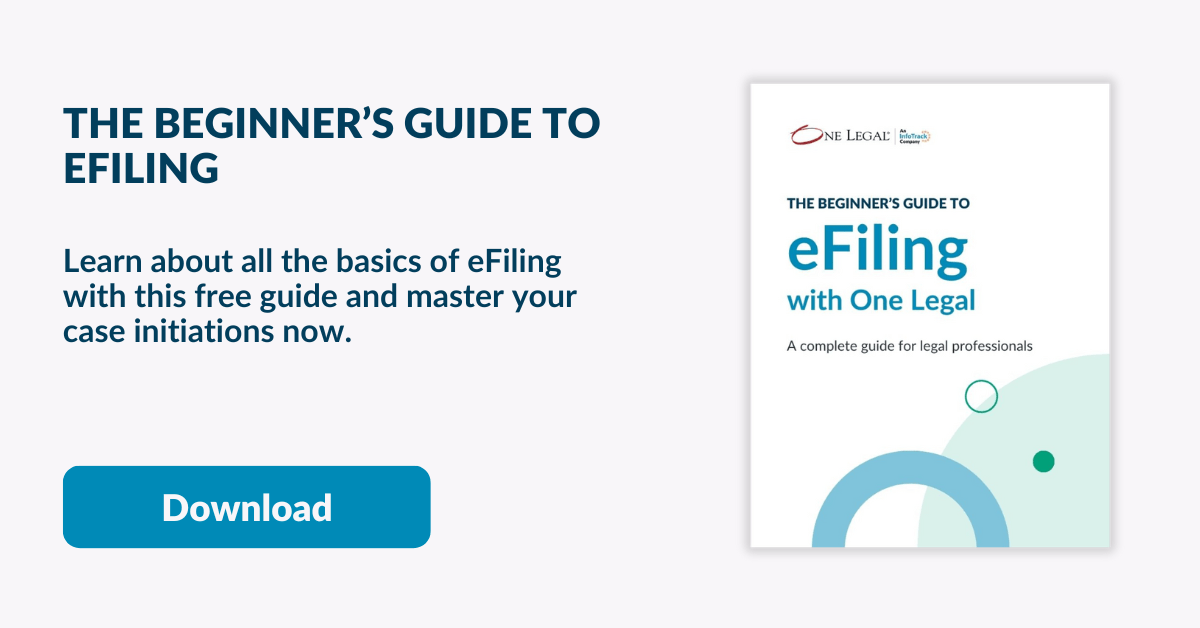
Learn all the basics about eFiling with this eBook guide. If you have a workflow that needs improving, are new to eFiling, or just want a handy companion guide to share with your colleagues, then this is for you. Download this free eBook now.
Share this article on social media:
More to explore.

Legal analysis 101: A complete guide

eFiling tips for California case initiations

Conflict of interest checklist for California law firms
What is one legal.
We’re California’s leading litigation services platform, offering eFiling, process serving, and courtesy copy delivery in all 58 California counties. Our simple, dependable platform is trusted by over 20,000 law firms to file and serve over a million cases each year.

All of your litigation support needs at your fingertips
© InfoTrack US, Inc.
- Accessibility statement
- Privacy policy
- Terms of service
Legal Up Virtual Conference
Register now to get actionable strategies and inspiration to level up your legal career.
- Skip to main content

- Find a Lawyer
- You've been hurt. Now what?
- Do I have a claim?
- Finding the best attorney to represent you
- Dealing with Insurance
- Laws by State
- Car accident
- Truck Accident
- Workplace injury
- Wrongful death
- Common work injuries
- Finding the best workers’ comp lawyers
- How workers’ comp benefits work
- Personal injury vs. workers’ compensation
- Spinal Cord/Column
- Brain Injury
- Occupational injuries
- Questions & Answers
- Tell Your Story
- Forms and Worksheets
- For Students
- Become a Partner
- Join lawyer directory
- Compare plans and features
- Guest blogging for attorneys
- Enjuris Excellence badge

Legal Research Tips Law Students Need to Know: The Basics

Seven tips on how to make legal research easier and more effective
Though many law students stress about writing in the proper IRAC format , composing the text is only half the battle. Without sound research, your memo or brief won’t carry any weight. Students often overthink their legal research, and that can lead to frustration and insufficient statutory and case law. This article identifies seven of the most efficient legal research strategies to make your legal writing process less arduous.
1. Identify the issue of your memo
All too often, students read the fact pattern of their client’s case and immediately start blindly searching Westlaw or LexisNexis , typing in all phrases that come to mind. Instead, law students need to take a deep breath and ask: “What is the client trying to achieve with this lawsuit?”
By identifying the cause of action, you can then ask: “What are the legal criteria that either help or hurt my client?” The answers to those two questions will formulate the legal issue. With those terms in mind, you can then use that phrasing to formulate the search phrase.
2. Narrow your jurisdiction
When students first start conducting legal research, they mistakenly cast too wide a net when it comes to jurisdiction. Desperate to find applicable law, students often look to states other than the appropriate jurisdiction to find relevant case law. Cases from other states, however, are persuasive authority, not mandatory. Persuasive authority holds little weight, so it should be scrapped from your memos unless your law professor or supervising attorney states otherwise.
The only cases that hold mandatory authority are Supreme Court decisions and those from the appropriate state. Federal cases from the corresponding circuit are also possible, but as those can be a bit trickier to apply, check with your law professor, TA or supervising attorney to make sure they were applied properly.
3. Use Boolean search terms
Though it may seem silly, many students will write the full issue statement into the search box. Westlaw and LexisNexis, however, actually run more like Google and typical search engines than people realize. With that in mind, mastering Boolean search terms will help you save time and yield more fruitful results.
For example, consider the following:
- If your issue reads, “Under Maryland law, can a property owner be considered negligent if a wild animal bites a guest on his property?”
- Then , your search phrase could state: “property owner” and “negligent” and “wild animal”
In this one search phrase, you target all 3 critical aspects of the issue. If your results become too limited, then you can eliminate either the quotation marks or one of the terms.
You certainly won’t become an expert in Boolean search terms overnight, but by practicing them now you can save a lot of time throughout your career.
4. Understand that helpful cases don’t have to have the legal outcome you want
Many times students avoid using the appropriate case law because the outcome wasn’t what the client wants. For example, why refer to a case where the defendant was found guilty if you are the defense attorney? The answer lies in an attorney’s ability to distinguish cases and maintain a sound argument. Your best case may be made by showing that your client is NOT like the plaintiff or defendant of the relevant case law.
The analysis section of your memo or brief allows you to navigate the comparison. For instance, your sentences may read something like:
- “Unlike the Smith case, our client… .”
- “While the Smith plaintiff had_______, our case is an example of_____.”
- “Though the defendant in Smith _________, we ask the court _______.”
By showing how the fact patterns are different, you can demonstrate how the court needs to find a different verdict toward your client. The caveat, however, is to make sure the laws are properly aligned. For example, don’t compare a case that maps out the law on medical malpractice when your case pertains to workers’ compensation.
5. If you find a helpful case, use that to find other cases
An entire article could be written on this tip. It’s perhaps the most helpful and often overlooked legal research tactic. Both Westlaw and LexisNexis offer legal research shortcuts that make a huge difference:
- Westlaw has “KeyCite,” while LexisNexis has “Shepardize” — though both do the same task. This tool allows you to see other cases that cited your case. The cases that include your case as “good law” are definitely options for you to peruse and possibly use as additional information. Even the cases that have negative treatment to the case you have in mind can still be used if you master the art of distinguishing the cases, as discussed above.
- When you’re reading a case in Westlaw or LexisNexis, the cases listed as authority are hyperlinked. Skimming the hyperlinked case is typically good idea because if that case had authority for the one you consider a match, it may hold weight for your client’s case as well.
- Lastly, when you first look at a case on WestLaw or LexisNexis, there are headnotes that provide key legal points within the case. Both programs allow you to view other cases that make use of the same headnote. If one headnote is on point, then a case with that same headnote is also worth a read.
6. Consider the date, but don’t obsess over it
As a rule of thumb, a more recent case is generally preferred. Newer cases often reflect the legal and societal changes that could affect the case law. Nevertheless, if you find a case that matches your fact pattern and applicable law but it’s 30 years old, don’t panic. That may be your best case because your client’s legal issue hasn’t appeared in recent years. Double-check to see the negative treatment of the older case to make sure it’s still good law. If there aren’t any red flags, that case is probably fine to use.
7. Know when to stop
Law professors and supervising attorneys want you to do your “due diligence” when it comes to legal research. Typing in 3 different searches into the search box and then giving up won’t win you any favors. By the same token, spending 4 hours researching a fairly typical case is also a big mistake .
You can’t view legal research as a hunt for a pot of gold. In many instances, you simply won’t find the exact case law or statute you’re looking for. When you feel as though you can’t possibly look any more, you probably can’t. Make use of what you found and write the best IRAC you can.
If possible, ask for another set of eyes. If it’s for a law school assignment, ask your TA or mentor to take a look to see if you might have missed something. If this is an internship assignment , ask your supervising attorney if you think you’ve done enough. Though you may feel like a failure if you haven’t found the case that will land your client a victory, know that plenty of lawyers often struggle to find the right law, too.
- How to Prepare for Law School
- Head start on legal research
- E-mail This Page
- Print This Page
How to do Legal Research in Law School
What are we going to cover?
Introduce you to an important skill for law students and lawyers.
How are we going to cover it?
Walk through the standard legal research process.
Why is it important to me as an incoming 1L?
You’ll have a class dedicated to legal research during the year, and learning legal research is part of the process of becoming a lawyer.
- The Process
- Starting Your Search
- 3 S’s of Legal Research

Question: What is “Legal Research?”
Answer: Legal research is the process of identifying and retrieving information necessary to support legal decision-making.
Question: So why do it?
Answer: Support legal decision-making:
- COMPLEX legal issues
- Applied to SPECIFIC facts
- Requiring COMPLETE answers
- For clients that PAY for your expertise
The Legal Research Process is based upon The Legal Research Pyramid
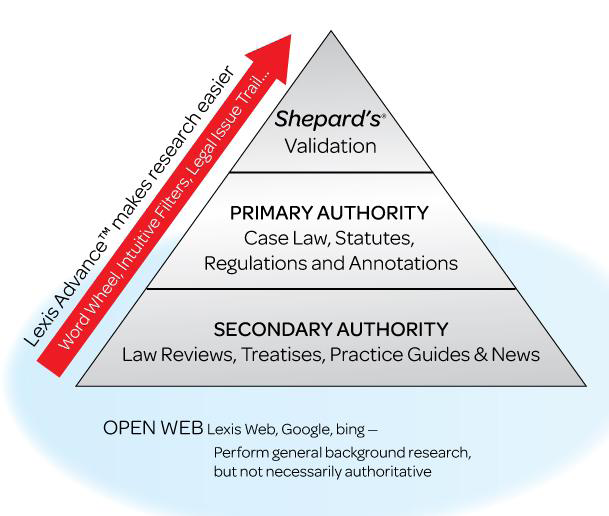
Starting on the Open Web such as Google and/or bing. This is a good place to start but:
- Not specific enough
- Rarely authoritative (can’t cite to Google in court)
- Credibility of sources is always a question
- Collapse All
Step #1:Legal Research Process
- Secondary Sources: Sources of information that describe or interpret the law, such as legal treatises, law review articles, and other scholarly legal writings, cited by lawyers to persuade a court to reach a particular decision in a case, but which the court is not obligated to follow.
- Don’t reinvent the wheel
- Learn from Legal Experts
- Get most important authority
- Read important background information
- Practice Guides
- Annotations & Digests
- Law Reviews & Journals
Step #2:Legal Research Process
- Primary Sources : A document that establishes the law on a particular issue, such as a case decision or legislative act.
- Authoritative
- Precedential
- Controlling
- Regulations
Step #3: Legal Research Process
- Shepardizing®: The process of consulting Shepard's® to see if a case has been overturned, reaffirmed, questioned, or cited by later cases.
- Your research needs to be “Good Law”
- You can’t use reversed or overruled authority
- See “Precedential Value”
- Shows if authority is overruled
- Ensures research is “Good Law”
Step #4: Rinse & Repeat?
- Law is Always Changing
- Legal research is never done
- Need to update your research as the law evolves
- Don’t find out your research is obsolete from opposing counsel
- Start with Secondary Sources
- Support with Primary Sources
- Shepardize ™
More Helpful Links
- The American Legal System
- How to Brief a Case
- How to Read a Casebook 101
- Top 20 Things You Need to Know About Law School
- Learn to Spot Issues Like a Lawyer
- Why an Internet Search is Not Legal Research
- Why go to Law School?
- What’s the Most Challenging Part of Law School?
- What advice would you give yourself about law school?

Get advice about law school from law students and legal professionals at the LexTalk legal community
Legal Research & Practical Guidance
Build your legal strategy and do vital work using authoritative primary law, analysis, guidance, court records and validation tools.
Search vast LexisNexis resources without selecting sources or using search commands.
Federal and state court dockets and documents for research, tracking, and profiling.
Practical Guidance
Current practical guidance from leading practitioners for managing transactional matters.
Lexis Securities Mosaic
Track and analyze SEC filings, U.S. agency information, industry news and current awareness.
News, Company Research & Media Monitoring Solutions
Quickly uncover up-to-date facts, news and insight essential to your decisions and business development.
LexisNexis Newsdesk
A fresh take on media monitoring & analysis to help you find the hidden gems that can impact your business.
Current, authoritative news, social media, company, financial and industry sources.
Media Intelligence Research & Analytics
Identify prospects and compile business profiles that help you close more deals.
Lexis Diligence
Corporate due diligence research tool.
- Intellectual Property
Stay up to speed with trends, track your competition, promote innovation and protect your intellectual assets.
TotalPatent One
The world's largest collection of full-text and bibliographic patent databases.
Patent Advisor
Predictive and revealing analytics for more efficient patent prosecution.
PatentOptimizer
Patent application drafting and analysis tools.
The CaseMap Suite of Litigation Tools
Comprised of four unique components, the CaseMap Suite can help you organize, analyze and present your entire case.
Compile relevant case facts, documents, research and issues into a centralized location for better assessment.
Manage litigation documents—share, search, review, produce, etc.—across your discovery team.
Quickly assemble your data and produce impactful timelines for pennies apiece.
See case presentations from a new angle with technology-driven Sanction software.
Practice & Legal Department Management
Address the business side of your legal activities with solutions to manage, track and analyze matters, finances, critical processes, relationships and performance.
CounselLink
A centralized repository for matter, e-billing and spend management.
Dashboards that display, track and manage your practice, clients and business tasks.
TimeMatters
Organize, associate and track case contacts, documents, events, phone calls, billing, etc.
InterAction
Comprehensive customer relationship management system for law firms.
Compliance & Due Diligence
Stay on top of regulatory and legislative changes, perform due diligence and manage compliance with ease, speed and confidence.
Customizable tools for tracking and reporting legislative and regulatory activity.
IntegraCheck | Integrity Due Diligence
In-depth due-diligence investigation reports.
Just for you Solutions & resources for your organization, department, role or individual work:
- Corporate Communications
- Information Professional
- Marketing & Competitive Intelligence
- Media Organizations
- Political Organizations
- Third-Party Due Diligence
- Sales & Business Development Professionals
- Strategy & Business Development Professionals
- Non-Profit Organizations
- Professional Services
- Technology Professionals
- Librarians & Information Professionals
- Paralegals & Legal Assistants
- Marketing Directors
- Law Department Management
- Litigation Management
- Tax Accounting
- View All »
- Faculty & Adminstration
- Public Libraries
- University & High School Students
- Law School Student Publications
- Portal Sign In
Browse by Industry
- Financial Services
- Health Care
- Life Sciences
- Manufacturing
- Retail & Sales
Browse by Department
- Corporate Compliance
- Corporate Counsel
- Procurement & Supply Chain
- Tax & Accounting
Visit the LexisNexis Store to purchase products that will assist you in your professional success Shop by :
- Jurisdiction
- Practice Area
- Banking Compliance
- Immigration
- Real Estate
- Workers' Comp
- Business Solutions
- Partner Products
- American Health Lawyers Association
- NITA: National Institute for Trial Advocacy
- The Florida Bar
Support & Training
Quick links.
- Lexis+ Support
- Lexis Support
- Nexis Support
- Practical Guidance Support
- CourtLink Support
- Lexis Securities Mosaic Support
- Digital Library Support
- LexTalk: Gain peer-to-peer, product support
- LexisNexis University
- Request Telephonic Training
- Support Center Resources
- Training on the Go
Communities & Blogs
Our Blogs and Communities feature a broad array of trending news and topics within socially interactive environments. Connect, explore and find the answers you need to further your goals.
- Blogs & Newsletters
- Blog Mosaic
- Business of Law Blog
- Corporate Law Advisory
- Legal Content Insider
- State Net Capitol Journal
- News & Trending Topics
- Legal Insights & Trends
- Practical Guidance Journal
- Professional Communities
- Business Insight Solutions – Partner Portal
- Corporate InfoPro (Corporate Information Professionals)
- InfoPro (Legal Information Professionals)
- LexisNexis for Developers
- Litigators Verdict & Settlement Exchange

Six Tips to Effectively Conduct Legal Research
Whether you’re a law school student, working at a prestigious law firm, or managing your legal practice, the significance of legal research cannot be overstated. It plays a pivotal role in helping you make well-informed decisions, construct persuasive arguments, and enrich your professional knowledge. Nonetheless, it’s widely acknowledged that legal research can be a time-consuming task, even for seasoned legal professionals. While many have streamlined their work by automating administrative tasks with the help of legal practice management software , legal research remains a manual process. To help enhance your proficiency in this important task, here are six tips to help you effectively conduct legal research.
What is Legal Research?
Legal research is the structured process of discovering answers to legal questions. It involves checking and understanding laws and court cases. This process includes identifying, collecting, and confirming the information and laws you need to make informed legal decisions.
During legal research, most attorneys refer to resources like legal reference books, in-depth law articles, and comprehensive legal journals. These resources serve as valuable tools for legal practitioners to navigate the complexities of the legal field and their specific cases.
Tips For Successful Legal Research
Define your research goal and stay focused.
Just like you would prepare for a court argument, it’s essential to plan your legal research ahead of time. Start by setting a clear goal for your research. Having a single objective in mind will help you stay focused and yield more favorable results.
In the sea of available information, it’s easy to get lost in every little detail when you’re just starting your research. Instead, keep your primary goal in mind and let it guide your analysis of cases, articles, and other materials. You can also create a concise mission statement to remind yourself of your intentions for this legal research.
Once you’ve established your research goal, dive into the case or cases that matter. Memorize or take notes of crucial case details, establish jurisdiction, and gain a deep understanding of the case’s context. This foundation will serve you well throughout the research process.
Organize Your Research
Once you’ve become well-acquainted with your case and have clarified the goals of your legal research, it’s time to ensure that your research process is structured and well-organized.
Among the most crucial steps you can take to optimize your research is keeping meticulous records. By documenting the sources you discovered, you will simplify the process of finding necessary sources when you start writing and explaining your research strategy. There are various ways to log your legal research. You can either jot down your notes on paper manually or use legal practice management software like PracticePanther to consolidate your notes digitally and link all notes to the relevant client and case. Regardless of the method you choose to store your legal research notes, best research logging practices usually include recording the date, keywords, and the process used. Additionally, it’s important to note any required follow-ups for each source you encounter.
Choose the Right Search Terms
When using online databases or search engines for your research, leverage the insights and objectives you’ve identified in your initial analysis to craft a set of precise search terms and key phrases. For instance, if you’re researching Texas copyright law, your search query may revolve around keywords such as “copyright infringement” and “Texas law.” Using specific terms in your searches makes it easy for you to discover the most relevant results.
You can also refine your queries by using Boolean search terms. For example, if your search includes the keywords “copyright infringement” and “Texas law,” search engines will retrieve results containing either “copyright infringement” or “Texas law.” However, if you wish to narrow down to sources that contain both keywords, simply use a Boolean operator like “AND” between them. This instructs the search engine to provide results featuring the specified keywords. Using Booleans in this manner streamlines your search, helping you quickly locate the sources you need without sifting through irrelevant results.
Diversify Your Sources
In legal research, it’s beneficial to explore a variety of sources. Combine primary sources like case records and witness testimonies with secondary sources such as commentaries, dictionaries, and journals for a comprehensive understanding.
Even cases that lack the outcome you desire can provide helpful insights for your purposes. For example, a case that ended in a guilty verdict can still offer valuable examples and precedents to consider as you’re building a defense closing argument.
Additionally, finding one relevant source can naturally lead you toward many others. For example, let’s say you find one law review that’s filled with helpful information. The chances are that this article will provide a treasure of references to other similarly valuable resources. Legal databases can make this process even more accessible, as many platforms have built-in functionality that can direct users to related articles, headnotes, and other sources.
While it may be tempting to focus solely on the most recent sources, that shouldn’t always be your approach. Even cases from decades ago can bring vital details or set significant precedents that impact your current project, provided they haven’t been overturned or the law hasn’t evolved.
Fact-Check Your Research
While it’s essential to gather comprehensive information for your case, it’s equally important to fact-check your sources and assess their credibility. Understanding the origins of your sources can be invaluable to ensure your sources are up-to-date and accurate. Additionally, always be mindful of potential biases in your sources, as legal literature may reflect the author’s perspective. Striving for objectivity in your research is as important as finding accurate sources.
Moreover, another strategy is to seek guidance from experienced attorneys or legal researchers. They can offer insights, share effective research strategies, and recommend trustworthy resources to ensure your legal research is up to par.
Pace Whenever You Can, Wherever You Can
One undeniable reality every lawyer encounters in their career is that legal research rarely yields the correct answer on the first attempt. Research can be inherently time-consuming, and it can be easy to get sucked into an endless loop of churning through databases searching for the perfect statute, article, or case.
However, the best researchers know when to stop. As you research, remember to take a step back every so often to evaluate your progress. If you find yourself encountering the same sources time and again, or if you’ve made all the headway you can realistically accomplish given your project’s timeframe, then it may be time to take a break or move on to writing.
Achieve Accuracy and Efficiency in Legal Research with These Actionable Tips
While legal research may seem overwhelming, by approaching it with a clear plan, verifying your sources, recognizing biases, staying updated, and seeking guidance from experienced colleagues, you can empower yourself to overcome even the most challenging research-related tasks. With diligence, the right tools, and these actionable tips, you can navigate the complexities of legal research with confidence.
If you are interested in discovering how PracticePanther can enhance your legal research note-taking process, schedule a time with our team today. Learn how our platform can assist you in efficiently managing your legal research while simultaneously handling your cases.
Download as PDF
Want a copy of this article? Download it for free!
Related Articles
8 Legal Podcasts to Help Grow Your Law Practice
Legal podcasts offer excellent content for legal professionals to stay current on tre...
5 Organization Tips for Lawyers to Stay Productive
Lawyers have a lot on their plates every day — managing casework, keeping track of de...
How to Write a Legal Cover Letter for Lawyers That Stands Out
Whether you’re a fresh grad just starting out or a legal professional seeking a new r...

PracticePanther
PracticePanther is a leading cloud-based law practice management software solution that serves tens of thousands of legal professionals in 170 countries. Through its intuitive and user-friendly interface, PracticePanther offers features in case management, time tracking, billing, client intake, payment processing, calendaring, eSignature, and much more to empower lawyers to automate their practices.
Subscribe for Updates
Learn how to grow your firm and get tips to save you time and automate your work, straight to your inbox.
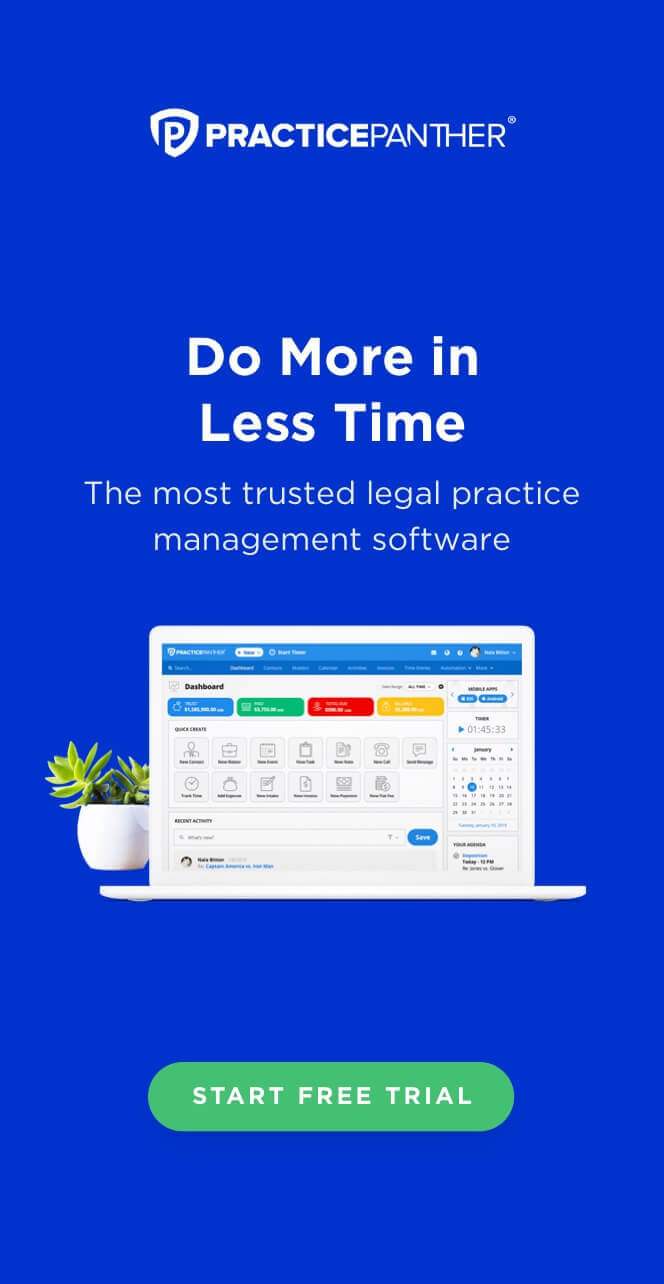
Download PDF
Submit this form to download this article as a PDF file.
- First Name *
- Last Name *
- Firm Name *
By submitting this form, you are agreeing to our Terms of Service and Privacy Policy
Start your free trial today
PracticePanther is the leading legal practice management software. Start a free trial today and discover the power of automation at your firm.
By creating an account, you are agreeing to our Terms of Service and Privacy Policy
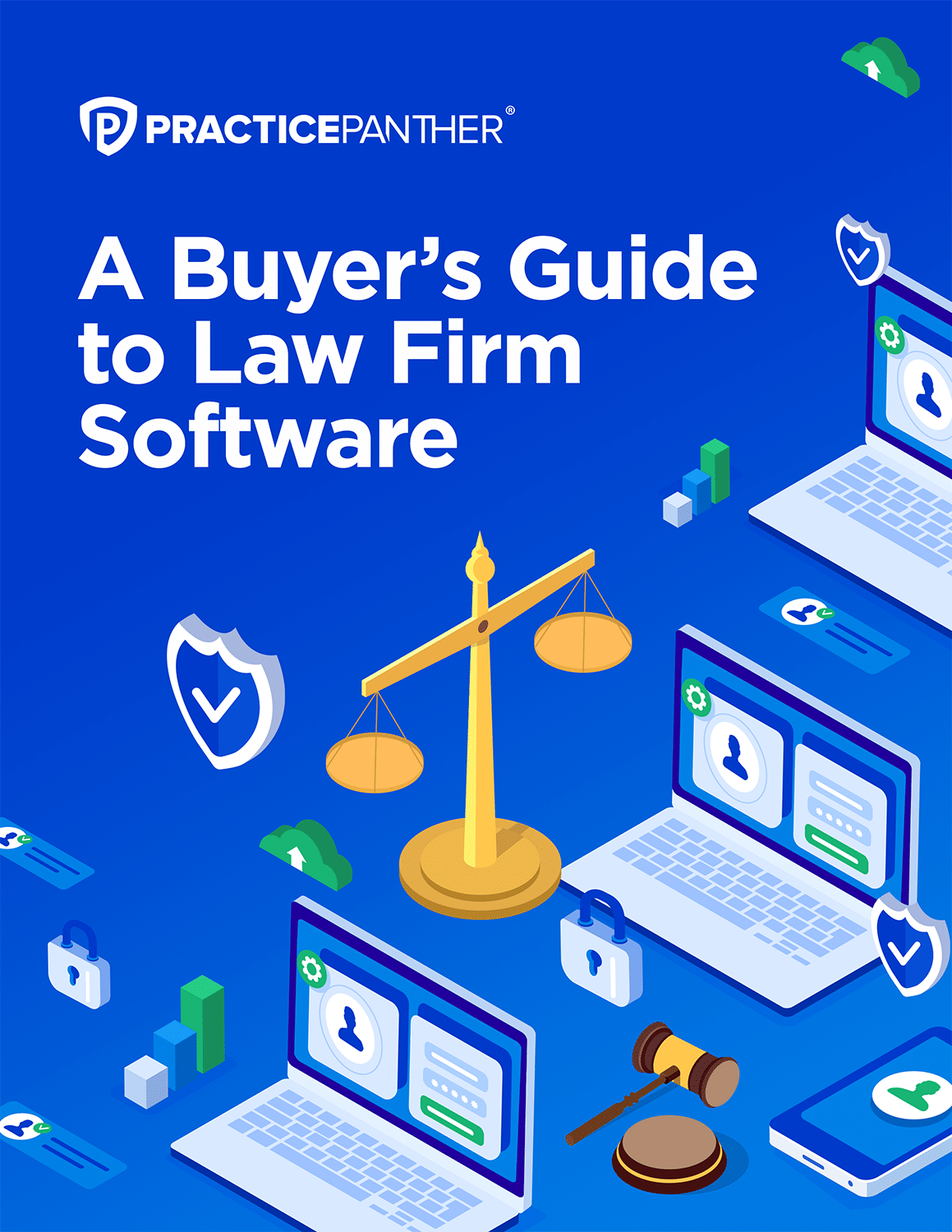
Download the Buyer's Guide to Law Firm Software
Maximize the security of your law firm's confidential information and improve productivity with the right law firm software. Explore crucial features to look for when choosing your law firm software.
Law practice management software made easy
We help you do right by your clients and get you home for dinner on time. Win-win.
Already have an account? Login
- Global directory Global directory
- Product logins Product logins
- Contact us Contact us
Our Privacy Statement & Cookie Policy
All Thomson Reuters websites use cookies to improve your online experience. They were placed on your computer when you launched this website. You can change your cookie settings through your browser.
- Privacy Statement
- Cookie Policy

Join our community
Sign up for industry-leading insights, updates, and all things AI @ Thomson Reuters.

Generative AI for legal professionals: What to know and what to do right now
AI is reshaping the legal landscape by providing invaluable support across various roles in law firms and legal departments. Rather than replacing legal professionals, gen AI enhances efficiency, accelerates tasks, and enables lawyers to focus on applying their expertise.

The benefits of being a technology trailblazer
Adopting technology early leads to better, faster, and more reliable legal research – setting a solid foundation for your legal matters.
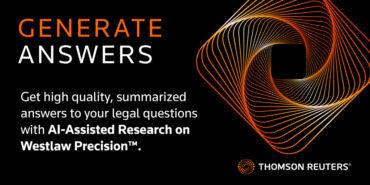
Westlaw Precision | Harness the power of generative AI
Innovative tools deliver advanced speed and accuracy, providing you with greater confidence in your legal research

Practical Law | Quick, expert answers to your ‘how do I’ legal questions
Get up to speed faster with Practical Law’s expertly created and maintained resources combined with powerful generative AI capabilities

CoCounsel: The GenAI assistant for legal professionals
Bringing together generative AI, trusted content, and expert insights for a new era of work.
Related posts

First-mover advantage: The future of generative AI use in corporate risk & fraud

A lawyer’s guide to legal tech: Optimizing processes and delivering a superior client experience

How AI can help you manage risks
More answers.

Five key takeaways from the ending of the Covid-19 Public Health Emergency (PHE) [infographic]

How teams analyze legal spend and billing data for predictive spend

Sanctions list and KYC: ‘How to overcome the challenges‘
How to Conduct Legal Research

IN THIS ARTICLE
Where do I begin my legal research?
What if i’m new to the practice area or specific legal issue, how do i respond to the opposing side’s brief, how can legal research help with drafting or strategy, how do i validate case law citations, how should i use technology to improve my legal research.
[Learn more about Bloomberg Law’s complete legal research resource – enabling smarter, faster decisions and confident action for your clients, practice, and organization.]
Conducting legal research can challenge even the most skilled law practitioners.
As laws evolve across jurisdictions, it can be a difficult to keep pace with every legal development. Equally daunting is the ability to track and glean insights into stakeholder strategies and legal responses. Without quick and easy access to the right tools, the legal research upon which case strategy hinges may face cost, personnel, and litigation outcome challenges.
Bloomberg Law’s artificial intelligence-driven tools drastically reduce the time to perform legal research. Whether you seek quick answers to legal research definitions, or general guidance on the legal research process, Bloomberg Law’s Core Litigation Skills Toolkit has you covered.
What is legal research?
Legal research is the process of uncovering and understanding all of the legal precedents, laws, regulations, and other legal authorities that apply in a case and inform an attorney’s course of action.
Legal research often involves case law research, which is the practice of identifying and interpreting the most relevant cases concerning the topic at issue. Legal research can also involve a deep dive into a judge’s past rulings or opposing counsel’s record of success.
Research is not a process that has a finite start and end, but remains ongoing throughout every phase of a legal matter. It is a cornerstone of a litigator’s skills.
[Learn how our integrated, time-saving litigation research tools allow litigators to streamline their work and get answers quickly.]
Beginning your legal research will look different for each assignment. At the outset, ensure that you understand your goal by asking questions and taking careful notes. Ask about background case information, logistical issues such as filing deadlines, the client/matter number, and billing instructions.
It’s also important to consider how your legal research will be used. Is the research to be used for a pending motion? If you are helping with a motion for summary judgment, for example, your goal is to find cases that are in the same procedural posture as yours and come out favorably for your side (i.e., if your client is the one filing the motion, try to find cases where a motion for summary judgment was granted, not denied). Keep in mind the burden of proof for different kinds of motions.
Finally, but no less important, assess the key facts of the case. Who are the relevant parties? Where is the jurisdiction? Who is the judge? Note all case details that come to mind.
While conducting legal research, it is easy to go down rabbit holes. Resist the urge to start by reviewing individual cases, which may prove irrelevant. Start instead with secondary sources, which often provide a prevailing statement of the law for a specific topic. These sources will save time and orient you to the area of the law and key issues.
Litigation Practical Guidance provides the essentials including step-by-step guidance, expert legal analysis, and a preview of next steps. Source citations are included in all Practical Guidance, and you can filter Points of Law, Smart Code®, and court opinions searches to get the jurisdiction-specific cases or statutes you need.

Searching across Points of Law will help to get your bearings on an issue before diving into reading the cases in full. Points of Law uses machine learning to identify key legal principles expressed in court opinions, which are easily searchable by keyword and jurisdiction. This tool helps you quickly find other cases that have expressed the same Point of Law, and directs you to related Points of Law that might be relevant to your research. It is automatically updated with the most recent opinions, saving you time and helping you quickly drill down to the relevant cases.
- Address your litigation research needs – day or night
No matter when you’re working, we’ve got the smarter, faster resources you need, including faster case law research, complete dockets access, and 24/7 expert support.
Whether a brief is yours or that of the opposing party, Bloomberg Law’s Brief Analyzer is an essential component in the legal research process. It reduces the time spent analyzing a brief, identifying relevant authorities, and preparing a solid response.
To start, navigate to Brief Analyzer available from the Bloomberg Law homepage, within the Litigation Intelligence Center , or from Docket Key search results for briefs.
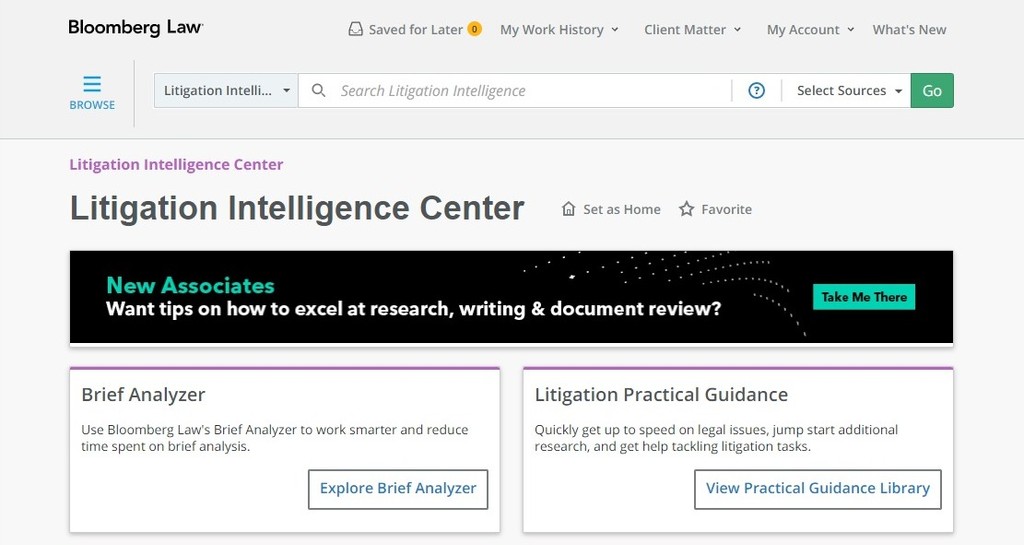
[ How to Write a Legal Brief – Learn how to shorten the legal research cycle and give your legal brief a competitive advantage.]
How to optimize your search.
Crafting searches is a critical skill when it comes to legal research. Although many legal research platforms, including Bloomberg Law, offer natural language searching, terms and connectors (also called Boolean) searching is still a vital legal research skill and should be used when searching across court opinions, dockets, Points of Law, and other primary and secondary sources.
When you conduct a natural language search, the search engine applies algorithms to rank your results. Why a certain case is ranked as it is may not be obvious. This makes it harder to interpret whether the search is giving you everything you need. It is also harder to efficiently and effectively manipulate your search terms to zero in on the results you want. Using Boolean searching gives you better control over your search and greater confidence in your results.
The good news? Bloomberg Law does not charge by the search for court opinion searches. If your initial search was much too broad or much too narrow, you do not have to worry about immediately running a new and improved search.
Follow these tips when beginning a search to ensure that you do not miss relevant materials:
- Make sure you do not have typos in your search string.
- Search the appropriate source or section of the research platform. It is possible to search only within a practice area, jurisdiction, secondary resource, or other grouping of materials.
- Make sure you know which terms and connectors are utilized by the platform you are working on and what they mean – there is no uniform standard set of terms of connectors utilized by all platforms.
- Include in your search all possible terms the court might use, or alternate ways the court may address an issue. It is best to group the alternatives together within a parenthetical, connected by OR between each term.
- Consider including single and multiple character wildcards when relevant. Using a single character wildcard (an asterisk) and/or a multiple character wildcard (an exclamation point) helps you capture all word variations – even those you might not have envisioned.
- Try using a tool that helps you find additional relevant case law. When you find relevant authority, use BCITE on Bloomberg Law to find all other cases and/or sources that cite back to that case. When in BCITE, click on the Citing Documents tab, and search by keyword to narrow the results. Alternatively, you can use the court’s language or ruling to search Points of Law and find other cases that addressed the same issue or reached the same ruling.
[Bloomberg Law subscribers can access a complete checklist of search term best practices . Not a subscriber? Request a Demo .]
Before drafting a motion or brief, search for examples of what firm lawyers filed with the court in similar cases. You can likely find recent examples in your firm’s internal document system or search Bloomberg Law’s dockets. If possible, look for things filed before the same judge so you can get a quick check on rules/procedures to be followed (and by the same partner when possible so you can get an idea of their style preferences).
Careful docket search provides a wealth of information about relevant cases, jurisdictions, judges, and opposing counsel. On Bloomberg Law, type “Dockets Search” in the Go bar or find the dockets search box in the Litigation Intelligence Center .
If you do not know the specific docket number and/or court, use the docket search functionality Docket Key . Select from any of 20 categories, including motions, briefs, and orders, across all 94 federal district courts, to pinpoint the exact filing of choice.

Dockets can also help you access lots of information to guide your case strategy. For example, if you are considering filing a particular type of motion, such as a sanctions motion, you can use dockets to help determine how frequently your judge grants sanctions motions. You can also use dockets to see how similar cases before your judge proceeded through discovery.
If you are researching expert witnesses, you can use dockets to help determine if the expert has been recently excluded from a case, or whether their opinion has been limited. If so, this will help you determine whether the expert is a good fit for your case.
Dockets are a powerful research tool that allow you to search across filings to support your argument. Stay apprised of docket updates with the “Create Alert” option on Bloomberg Law.
Writing a research memo? Here’s a how-to guide.
Bloomberg Law subscribers can access our expert-written guide on writing a research memo, authored by Aaron Goodman, Of Counsel at Baker McKenzie.
Not a subscriber? Request a demo
Dive deeper into competitive research.
For even more competitive research insights, dive into Bloomberg Law’s Litigation Analytics – this is available in the Litigation tab on the homepage. Data here helps attorneys develop litigation strategy, predict possible outcomes, and better advise clients.
To start, under Litigation Analytics , leverage the Attorney tab to view case history and preview legal strategies the opposition may practice against you. Also, within Litigation Analytics, use the Court tab to get aggregate motion and appeal outcome rates across all federal courts, with the option to run comparisons across jurisdictions, and filter by company, law firm, and attorney.
Use the Judge tab to glean insights from cited opinions, and past and current decisions by motion and appeal outcomes. Also view litigation analytics in the right rail of court opinions.
Docket search can also offer intel on your opponent. Has your opponent filed similar lawsuits or made similar arguments before? How did those cases pan out? You can learn a lot about an opponent from past appearances in court.
Checking the status of case law is essential in legal research. Rely on Bloomberg Law’s proprietary citator, BCITE. This time-saving tool lets you know if a case is still good law.
Under each court opinion, simply look to the right rail. There, you will see a thumbnail icon for “BCITE Analysis.” Click on the icon, and you will be provided quick links to direct history (opinions that affect or are affected by the outcome of the case at issue); case analysis (citing cases, with filter and search options), table of authorities, and citing documents.
A significant benefit of digital research platforms and analytics is increased efficiency. Modern legal research technology helps attorneys sift through thousands of cases quickly and comprehensively. These products can also help aggregate or summarize data in a way that is more useful and make associations instantaneously.
For example, before litigation analytics were common, a partner may have asked a junior associate to find all summary judgment motions ruled on by a specific judge to determine how often that judge grants or denies them. The attorney could have done so by manually searching over PACER and/or by searching through court opinions, but that would take a long time. Now, Litigation Analytics can aggregate that data and provide an answer in seconds. Understanding that such products exist can be a game changer. Automating parts of the research process frees up time and effort for other activities that benefit the client and makes legal research and writing more efficient.
[Read our article: Six ways legal technology aids your litigation workflow .]
Tools like Points of Law , dockets and Brief Analyzer can also increase efficiency, especially when narrowing your research to confirm that you found everything on point. In the past, attorneys had to spend many hours (and lots of money) running multiple court opinion searches to ensure they did not miss a case on point. Now, there are tools that can dramatically speed up that process. For example, running a search over Points of Law can immediately direct you to other cases that discuss that same legal principle.
However, it’s important to remember that digital research and analytical tools should be seen as enhancing the legal research experience, not displacing the review, analysis, and judgment of an attorney. An attorney uses his or her knowledge of their client, the facts, the precedent, expert opinions, and his or her own experiences to predict the likely result in a given matter. Digital research products enhance this process by providing more data on a wider array of variables so that an attorney can take even more information into consideration.
[Get all your questions answered, request a Bloomberg Law demo , and more.]
Reference Shelf
- Litigation Essentials – Legal Tech Tools for the Modern Practitioner
- Six Steps to an Efficient Litigation Workflow
- Give Your Legal Brief a Competitive Advantage
- Artificial Intelligence for Lawyers Explained
- Litigators Sound Off on Their Most Time-Consuming Task
- The Art of the Brief: Critical Mistakes and How to Avoid Them
US Law Week Articles
Social media a ‘double-edged sword’ for students, judge says, amazon splits c-suite general counsel, corporate secretary jobs, texas pushback on pro-palestine protests draws free speech suit.
How to do Legal Research?
Manupatra Video Resources on Legal Research covers everything from basic steps to begin legal research, how to write a research paper, how to research for a moot as well as tips and tricks to make the most of Manupatra Features.

👇 Recommended LLS Courses to Excel in this Opportunity

Home » Blogs, News, Advice » Legal Education » Legal Research Techniques for Finding Relevant Case Law
Legal Research Techniques for Finding Relevant Case Law
- Aug 8, 2023
- No Comments
Legal research is a systematic finding or ascertainment of law on an identified topic or in a given area. Additionally, it is a legal inquiry into the existing scholarship to advance the science of law.
Case law research and analysis is a prerequisite in the process of legal research. The method of acquiring this skill starts as soon as one embarks upon the journey of learning, studying, exploring and most importantly applying the law in a practical scenario.
Reading a case law, comprehending the rationale behind the decision and relating it to the present case to build a compelling and coherent argument is a skill every lawyer not only aspires to acquire. In order to become proficient and accomplished in their chosen profession, every lawyer must be skilled in finding relevant case laws through different means. One can learn several legal research techniques to find relevant case laws in legal databases.
Read on to find out several tools and techniques of Legal Research.
What are the different types of Legal Research?
Different types of research are crucial in case law research as they provide varied perspectives and information. Legal research helps identify relevant statutes, regulations, and precedents.
By utilizing these different research methods, researchers can obtain a comprehensive understanding of the legal landscape and make well-informed arguments or decisions in case law research. There are several legal research methodologies available for researchers to pursue their research.
1. Descriptive & Analytical Research
Descriptive research methodology focuses more on the “what” of the subject than the “why” of the research question. It is a description-based methodology that studies the characteristics of the population or phenomenon. The analytical research, however, uses the facts and information available to make a critical evaluation.
2. Qualitative & Quantitative Research
Qualitative legal research is a subjective method that relies on the researcher’s analysis of the controlled observations. In Quantitative Legal Research, one collects data from existing and potential data using sampling techniques like online surveys, polls, & questionnaires. The researcher can represent the outcomes of the quantitative study numerically.
3. Doctrinal & Empirical Research
In doctrinal legal research, the researcher analyses the existing statutory data to find the relevant answer to “What is the Law?” However, in empirical research, the researcher creates new data using several data collection methods and uses statistical tools to analyze it.
What is the Case Law Technique in Legal Research?
Case laws are the primary sources, i.e., the most original source, used in all legal research methodologies.
The case law technique in legal research methodology studies judicial opinions or decisions, and it is the technique of finding relevant legal precedents and principles. This is more challenging than it sounds because finding applicable case laws from legal databases is confusing and time-consuming, if the researcher is not well-versed with the tools.
Like legislation, case law can also be challenged and consequently change over time, as per the changing needs of the society. An earlier decision does not guarantee that it will always remain the law of the land.
Therefore, a lawyer must be skilled at finding, reading, and ascertaining the relevance, applicability and legal standing of any case law at a given point of time. . Thus, the importance of case law technique in legal research is quite significant as there can be no legal research without delving deep into judicial decisions.
How to Do Legal Research for Case Laws?
Before the time of the web, legal databases were in the form of multi-volume bulky books and digests. Researchers had to locate the cases manually with the help of case citations which was extremely time consuming. Though these periodicals are still available, online legal databases have overpowered them owing to their easy accessibility and time-saving tendency.
The Offline Tools for Legal Research
The researcher can locate case laws using the citations in printed law reporters. For example, the citation of a case is AIR 2017 SC 57, here the name of the Law Reporter in which the case law is published is AIR (All India Reporter), the year of the judgment is 2017, SC (Supreme Court) is the name of the Court, and the page number of the printed reporter on which the judgment can be found is 57.
The format of citation differs for every law reporter. Thus, the first step for locating the proper case law using citation is to decode the name of the law reporter.
The law reporters also categorize all the case laws. Thus, if the researcher does not know the case citation, they can find the case law as per its category.
The Online Tools for Legal Research
Using online tools for finding case laws is relatively easy. Even if the researcher does not know the name, citation, or year of the judgment, they can still find the same or similar judgments, thanks to these online tools’ intelligent features.
The only drawback is the majority of these tools require a heavy subscription fee which is not ideal for everyone.
What are the Methods of Locating Relevant Case Laws?
A researcher can locate relevant case laws if they know either of the following:
The identity of the case in law reporters, usually denoted in a combination of words & numbers.
For example: (1973) 4 SCC 225; AIR 1973 SC 1461
Case number
The official number the Court gives to a particular case.
For example: W.P.(C) 135 OF 1970
Name of the Parties
Either party’s name can be used for finding the case law.
For example: Petitioner’s name- Kesavananda Bharati Sripadagalvaru
Respondent’s name- State of Kerala
Jurisdiction
A researcher can filter their finding by deciding which Court’s judgment they want to look for.
A researcher can refer to various statute-based legal databases while finding a case law pertaining to a particular statute.
For example: The Labour Law Reporter publishes judgments specifically related to the Labour Laws of India.
How to Find Relevant Case Laws in India?
The offline tools.
The Supreme Court Reports (SCR) are the only authorized Indian law report series, and Supreme Court decisions should be cited from here whenever possible. However, Supreme Court Reporters are about four years behind in publishing the cases. Because of the long delay in the publication of the SCR. Therefore, it is entirely acceptable to cite a few unauthorized reports in academic and judicial work.
All India Reporter (AIR) is often cited in preference to the SCR, and in the Indian courts it has the status of an authorized series. The Law Library has the AIRs in print.
Online Tools
- Supreme Court of India at main.sci.gov.in . All the latest judgments by the Supreme Court of India are available here.
- Judgment Search Portal at judgments.ecourts.gov.in/pdfsearch/index.php : You can find the old Supreme Court Judgments here by entering any related keyword. It can be the citation of the case, name of the parties, case number, nature of the case, etc.
- SCC Online at www.scconline.com : India’s premier legal database with access to complete coverage of the Supreme Court, all High Courts, Tribunals and Commissions, Statutory Material and many foreign jurisdictions’ and International material. Individual registration is required to use this online legal database .
- AIROnline at www.aironline.in : Again, a subscription-based legal database which covers the judgments of all Supreme Courts, all High Courts, Tribunals and Commissions. The subscribers can find the case laws through citations, individual words, or exact phrases.
- Manupatra at www.manupatrafast.com : Indian case law coverage includes full-text decisions from the Supreme Court, all High Courts, the Federal Court, Privy Council and many tribunals. It covers judgments from the inception of each Court. The legislations covered include bare acts, amending acts, repealed legislation, subordinate legislation and bills from all jurisdictions. The primary material is grouped by topic; the secondary material comprises annotated legislation and commentary.
- Indian Kanoon at indiankanoon.org contains unreported decisions and is more up-to-date by a few days than the unreported cases on Manupatra or SCC Online. It goes back further (for example, Supreme Court cases started in 1947 in Kanoon and 1950 in Manupatra).
If you are looking for very recent decisions or if it is optional to access a reported version of the case, use Kanoon. Citation, party names, keywords, Court, date range etc., can search it. Researchers can also browse Indian Kanoon by Court and year. Indian Kanoon is also free!
However, Indian Kanoon tends to provide fewer parallel citations than Manupatra. It relies on user-generated content, lacks official verification, may contain outdated or inaccurate information, and sometimes does not provide comprehensive access to all relevant legal materials and judgments.
The approach to case law research has changed globally and in India due to technological advancement. According to statistics, roughly 33.9% of lawyers begin their research by using Google. Because Google is a generic search engine, the search results may sometimes be vague. Hence, case law databases or search engines that are tailor-made for lawyers emerge.
Lawctopus Law School’s Legal Research & Writing Course helps law students and legal professionals in understanding a crisp way to conduct Legal Research of different techniques and the right way to use legal databases.

Join Our WhatsApp Channel for Opportunity Updates
Get Daily Updates

Join Our Blogs, News, Advice Telegram Group

Get an Internship
Add a Comment Cancel reply
Your email address will not be published. Required fields are marked *
Advertisement

🎦 Learn about Data Privacy Law in the Age of AI. Join this free webinar
For Advertisements on Lawctopus
- +91 90235 43927
- [email protected]
- Office hours: 11AM - 7PM
For Lawctopus Law School
- +91 80474 94091
- [email protected]

Download our eBook on
Get An Internship

An official website of the United States government
Here’s how you know
The .gov means it’s official. Federal government websites often end in .gov or .mil. Before sharing sensitive information, make sure you’re on a federal government site.
The site is secure. The https:// ensures that you are connecting to the official website and that any information you provide is encrypted and transmitted securely.

Researching the Federal Securities Laws Through the SEC Website
Introduction.
This guide provides an overview of how to research the securities law through the SEC website and is provided as a service to investors and members of the public. It is neither a legal interpretation nor a statement of SEC policy. If you have questions concerning the meaning or application of a particular law or rule you should consult with an attorney who specializes in securities law. This guide does not address primary and secondary sources available in print or through other websites, other than those to which the SEC website links. The guide is organized by providing suggestions for the research of:
- Statutes (the Securities Laws)
- SEC Rules and Regulations;
SEC Concept Releases
Sec interpretive releases, sec staff interpretations.
In general, you should conduct your research on the federal securities laws in the order prescribed above. This is because while the federal statutes and the SEC rules and regulations have the force of law, other SEC-issued documents vary in the degree to which they carry the force of law. SEC Staff documents have no legal force or effect: they do not alter or amend applicable law, and they create no new or additional obligations for any person.
Major pieces of legislation, such as the Securities Act of 1933, the Securities Exchange Act of 1934, and the Investment Company Act of 1940, provide the framework for the SEC's oversight of the securities markets. These statutes are broadly drafted, establishing basic principles and objectives. The laws that govern the securities industry include:
- Securities Act of 1933
- Securities Exchange Act of 1934
- Trust Indenture Act of 1939
- Investment Company Act of 1940
- Investment Advisers Act of 1940
- Securities Investor Protection Act of 1970
- Public Company Accounting Reform and Corporate Responsibility Act of 2002 (Sarbanes-Oxley Act of 2002)
- Wall Street Reform and Consumer Protection Act of 2010 (Dodd-Frank Act of 2010)
You can find general descriptions of the objectives of each of these statutes in the “ About the SEC ” section of our website. The web pages of the Division of Investment Management and the Division of Corporation Finance also provide links to the federal securities laws and regulations that relate to the areas that each Division oversees.
TIP: The SEC website links to the text of the federal securities laws provided by the House Committee on Financial Services. The texts include references to the United States Code (U.S.C). U.S.C. citations are the official citations for federal laws. You can find the securities laws in Title 15 of the U.S.C. For example, the Securities Act of 1933 is 15 U.S.C. § 77a et seq.; the Securities Act of 1934 is 15 U.S.C. § 78a et seq.; the Investment Company Act of 1940 is 15 U.S.C. § 80-1 et seq.; and the Investment Adviser Act is 15 U.S.C. §80b-1 et seq.
Legislative History
Legislative history is the official record of the passage of a statute. It is useful if you are looking for Congressional intent at the time Congress passed a particular statute. Although our website does not link to the legislative history of the securities laws, we provide a link to the Library of Congress’ Congress.gov online database. Congress.gov is the official website for U.S. federal legislative information. The site provides access to accurate, timely, and complete legislative information for Members of Congress, legislative agencies, and the public.
SEC Rules and Rulemaking
Rulemaking is the process by which federal agencies implement legislation passed by Congress and signed into law by the President. The SEC engages in rulemaking to maintain fair and orderly markets and to protect investors by altering regulations or creating new ones. There are both official and unofficial sources of SEC rules and regulations.
NOTE: If you are researching administrative regulations, including SEC rules, you always should check whether they are current. You also should check the coverage and status of all sources.
Official Sources
- The Federal Register . The Federal Register is the official daily publication where the SEC and other federal agencies first publish proposed regulations for comment, adopted final regulations, explanations of actions taken, and announcements of significant interpretations of the law. The Regulatory Actions section of our webpage may include links to the Federal Register publication of a specific rule. If our web pages do not link to a Federal Register release, you can find a copy of the release by going to the website of the U.S. Government Printing Office .
- 17 CFR, part 230 - Securities Act of 1933
- 17 CFR, part 240 - Securities Exchange Act of 1934
- 17 CFR, part 260 - Trust Indenture Act of 1939
- 17 CFR, part 270 - Investment Company Act of 1940
- 17 CFR, part 275 - Investment Advisers Act of 1940
- 17 CFR, part 300 - Securities Investor Protection Act (Rules of SIPC)
You can find other frequently requested material in the CFR at:
- 17 CFR, part 200 - General SEC Rules (includes organization of SEC, codes of conduct and ethics; information requests)
- 17 CFR, part 201 - SEC Rules of Practice
- 17 CFR, part 202 - Informal Procedures
- 17 CFR, part 203 - Investigations
- 17 CFR, part 210 - Regulation S-X
- 17 CFR, part 229 - Regulation S-K
- 17 CFR, part 242 - Regulation M, SHO, ATS, AC, NMS
- 17 CFR, part 248 - Regulation S-P, S-AM, and S-ID (includes ID Theft and Protection of Customer Information)
Tip: Individuals often refer to SEC rules and regulations by the number only, without reference to the entire CFR citation. However, you need the full CFR citation to find a specific rule. For example if you are looking for Rule 10b-5 of the Securities Exchange Act of 1934, the citation is 17 CFR 240.10b-5. An idiosyncrasy of the federal securities laws is that the term “regulation” often refers to a collection of rules for example, Regulation S-K and Regulation SHO .
The SEC's website provides access to regulations codified in the CFR. In addition, the SEC’s website includes selected rules and regulations on the Forms web page.
CFR Titles are updated annually. Therefore if you are researching recent rulemaking, you should check GPO’s website for the monthly “ List of CFR Sections Affected .” (LSA). As noted on GPO’s web page, the LSA “lists proposed, new, and amended Federal regulations that have been published in the Federal Register since the most recent revision date of a CFR title. Each LSA issue is cumulative and contains the CFR part and section numbers, a description of its status (e.g., amended, confirmed, revised), and the Federal Register page number where the change(s) may be found.”
The CFR references the Federal Register citation for the original adopting release as well as any releases amending the rule or regulation.
Unofficial Sources
The “ Regulatory Actions ” section of our website is an unofficial source of both Final and Proposed Rulemaking Releases. You should note that the date of the releases reported on our website is the date of the Commission’s approval and not the publication date in the Federal Register.
The “ Rulemaking Index ” section of our website lists rulemaking activity since 2008 grouped by file number, which allows you to view the proposed rules, final rules and other actions related to a particular rulemaking. You can sort this list by most recent action, file number, or the informal short name of the rulemaking. By using the "Status" filter, you can view rulemakings that have been completed, or rulemakings that have been proposed but not yet completed. You can also filter to display rulemakings related to a specific SEC division or office. This index omits certain technical rulemakings, including updates to the EDGAR filing manual.
Tip: Rulemaking releases, unlike the text of the rules found in the CFR, provide in-depth background information about the origin of specific rules. The releases include, for example, the Commission’s basis for proposing or adopting the rule, changes from earlier proposed rules, and a summary of public comments.
- Final Rules. Final rules releases dating back to September 1994 are available on our website as are selected rulemaking releases for the period from 1962 to 1994. The Details section for a particular release will include links to the proposed rule(s), comments, and also identify the effective date and the compliance date (where appropriate). The “Final Rules” section also will include amendments or corrections to the rule as well as notices of extensions or compliance dates.
- Proposed Rules. The “ Proposed Rules ” web page includes links to the releases of proposed rules and links to public comments about the rules. We also post the Federal Register version of the release. You can find the proposed rules by looking for either the release number (in some cases the first of several release numbers for the specific rule) or by date. The web page does not organize the proposed rules by subject matter or by file number. The website includes proposed rules going back to 1994.
What Is an Effective Date?
The effective date is the date on which a rule or regulation begins to apply and becomes enforceable.
What Is a Compliance Date?
The compliance date is the date on which the entities covered by the rule must comply with the rule.
What Do the Prefixes to the Release Numbers Mean?
The prefixes included in the release numbers identify the Act pursuant to which the rule was promulgated. Common prefixes are:
33-: Securities Act of 1933 34-: Securities Exchange Act of 1934 39-: Trust Indenture Act of 1939 IA-: Investment Advisers Act of 1940 IC-: Investment Company Act of 1940 FR-: Financial Releases (should not be confused with citations to the Federal Register)
If you are researching a rule by release number, you can use the search engine at the top of our home page. This will help you to locate a release in the event that this is not the release number identified on the rulemaking pages.
What Is the Difference Between an SR- and an S7- File?
S7- files are the file numbers assigned to Commission rules. SR-files refer to rules of the self-regulatory organizations.
The Commission occasionally publishes "concept" releases to solicit the public's views on securities issues so that we can better evaluate the need for future rulemaking. The Regulatory Actions section of our website includes concept releases dating back to 1994.
The Commission occasionally provides guidance on topics of general interest to the business and investment communities by issuing "interpretive" releases , in which we publish our views and interpret the federal securities laws and SEC regulations. Interpretive releases (like concept releases) are not enforceable laws and regulations but provide useful guidance as to the position of the Commission on various issues. The “ Interpretive Release ” web page includes interpretive releases from 1995 to the present. The Interpretive Release web page does not organize the releases by topic. However, the web page for the Division of Corporation Finance includes interpretive releases and other information, organized by subject category, dating back to 2002. The Division of Trading and Markets’ and Division of Investment Management’s web pages also include interpretive releases.
Tip: The CFR includes indices of interpretive releases of the Commission, organized by the relevant Act. The CFR includes the Federal Register citation. For example, you can find citations for interpretive releases covering the Securities Exchange Act at 17 CFR, part 241 .
SEC Policy Statements
From time to time, the Commission issues a " policy statement " to clarify its position on a particular matter. The policy statements include interagency statements. You can find the policy statements on our “ Policy Statements ” web page.
The SEC staff provides informal guidance through various oral and written statements. Because they represent the views of the staff, these statements have no legal force or effect: they do not alter or amend applicable law, and they create no new or additional obligations for any person. You can find links to the available statements through the Staff Interpretations section of our website.
SEC Staff Legal and Accounting Bulletins
Staff Legal Bulletins summarize SEC staff's views regarding various aspects of the federal securities laws and SEC regulations. They represent interpretations and policies followed by the Divisions of Corporation Finance, Trading and Markets, or Investment Management on any given matter.
Staff Accounting Bulletins reflect SEC staff's views regarding accounting-related disclosure practices. They represent interpretations and policies followed by the Division of Corporation Finance and the Office of the Chief Accountant in administering the disclosure requirements of the federal securities laws. You also can find the Codification of Staff Accounting Bulletins on our website.
No-Action, Exemptive and Interpretive Letters
No-action, exemptive and interpretive letters issued by the staff members of the Divisions of Corporation Finance, Trading and Markets, and Investment Management posted on our website date back to 2002. Staff Letters to Industry from the staff of the Office of the Chief Accountant are posted from 1998 to the present. No-action letters are inquiries sent by individuals or entities about a specified proposed conduct seeking the SEC staff’s views as to whether it would recommend an enforcement action in the event that the proposed conduct occurs.
Where to Obtain SEC Materials Not Available on Our Website
You can request SEC rules and other materials not available on our website by accessing How to Request Public Documents .
Where to Go for Additional Assistance
If you need assistance in find SEC laws or regulations on our website, please call the Office of Investor Education and Advocacy at 1-800-732-0330 or use our Questions and Comments Form .
Featured Content

Investing Quiz – May 2024
Test your knowledge of diversification, individual retirement accounts (IRAs), and more!

Free Financial Planning Tools
Access savings goal, compound interest, and required minimum distribution calculators and other free financial tools.

10 Questions to Consider Before Opening a 529 Account
Are you saving for college or other educational expenses? Read our Investor Bulletin to find answers to your questions about 529 plans.

How to Open a Brokerage Account
Read our Investor Bulletin to learn what to expect when opening a brokerage account.
Sign up for Investor Updates
Trending News

Related Practices & Jurisdictions
- Communications, Media & Internet
- Law Office Management
- All Federal

LinkedIn is a powerful tool for law firms to elevate their presence and foster meaningful connections. This professional networking platform, with its many functionalities, is an invaluable asset for law firms and the legal marketers who work at these firms, enabling them to showcase their firm’s expertise, build relationships and gain insights into industry trends and analytics. By embracing LinkedIn’s capabilities, legal marketers can use LinkedIn to significantly enhance their firm’s market visibility and create avenues for growth and opportunity. Here’s how legal marketers at any size firm can use LinkedIn to support their law firms and their lawyers.
Networking and Relationship Building
Networking on LinkedIn goes beyond adding connections; it’s about nurturing and maintaining professional relationships. Legal marketers can leverage their network to facilitate introductions between lawyers and potential clients or referral sources. Engaging regularly with connections through comments, shares and messages can solidify these relationships and create a strong professional network that benefits the firm. Here’s how legal marketers can effectively network and build relationships on the platform:
- Targeted Connection Requests: Identify and send personalized connection requests to potential clients, referral sources, industry leaders and alumni. Tailor each request with a note that mentions common interests or mutual connections to make it more engaging.
- Regular Engagement: Actively engage with your connections’ content by liking, commenting and sharing. Thoughtful comments and interactions can spark conversations and strengthen relationships.
- Share Valuable Content: Regularly post relevant and informative content that reflects your firm’s expertise and values. This helps in keeping your network informed and engaged with your firm’s activities and achievements.
- Personalized Messages: Send personalized messages to new connections to welcome them to your network and express your interest in learning more about their work. Avoid generic messages or sales pitches.
- Facilitate Introductions: Act as a connector by introducing your connections to each other where you see potential synergies. This can be particularly beneficial for lawyers in your firm looking to expand their client base or professional network.
- Use LinkedIn Groups: Join and actively participate in LinkedIn groups relevant to your industry. This can help in expanding your network and establishing your presence in these professional circles.
- Host Virtual Events: Organize webinars or virtual roundtables on LinkedIn and invite your connections. This provides an opportunity for live interaction and deepens relationships.
- Monitor and Respond to Engagement: Keep an eye on who interacts with your posts and messages and respond promptly. Acknowledging engagement shows that you value the interaction and helps in fostering a stronger connection.
- Schedule Regular Check-ins: Periodically check in with your connections to catch up or share updates. This can be done through LinkedIn messages or by sharing relevant content with them.
Content Amplification
LinkedIn is an excellent platform for sharing news about the firm, its lawyers and their accomplishments. By encouraging lawyers and firm members to share and interact with these posts, legal marketers can increase the firm’s visibility. The platform’s algorithm favors content that generates engagement, making this an effective strategy to position the firm and its lawyers as thought leaders in their areas of expertise. Here’s how legal marketers can effectively amplify content on this platform:
- Create Shareable Content: Develop engaging content that lawyers and firm employees will want to share. This includes updates about the firm, achievements, insightful articles and posts highlighting the expertise of the firm and its lawyers.
- Encourage Sharing Within the Firm: Actively encourage lawyers and staff to share firm-related content on their personal LinkedIn profiles. This can be facilitated through internal communications or incentives that promote engagement with the firm’s content.
- Utilize Employee Advocacy Programs: Implement an employee advocacy program where lawyers and staff are provided with pre-approved content to share. This not only ensures consistency in messaging but also expands the reach of each post to their networks.
- Engage with the Content: Encourage lawyers and staff to not only share content but also interact with it through likes, comments and shares. Engagement from within the firm can stimulate further external engagement.
- Leverage Hashtags and Tags: Use relevant hashtags and tag appropriate individuals and organizations to increase the visibility of your posts. Hashtags should be relevant to the legal industry and the specific content of the post.
- Consistent Posting Schedule: Maintain a regular posting schedule to keep the audience engaged and ensure consistent visibility on the platform.
- Cross-Promote Content: Share LinkedIn content across other social media platforms and in newsletters to reach a wider audience. Include links to your LinkedIn posts to drive traffic back to the platform.
- Use LinkedIn’s Publishing Platform: Encourage lawyers to publish articles directly on LinkedIn. This feature allows for longer-form content that can showcase the firm’s expertise more extensively.
- Monitor and Respond to Engagement: Regularly monitor the engagement on your posts and respond to comments to foster conversations. This increases the engagement rate, which is favored by LinkedIn’s algorithm.
- Analyze Performance: Use LinkedIn analytics to understand which types of content perform best. This insight can guide future content creation and amplification strategies.
Showcasing Firm Expertise
Showcasing your firm’s expertise on LinkedIn is a strategic way to stay top of mind with your clients, attract potential clients, engage with recruits and reinforce the firm’s reputation. Here’s how legal marketers can effectively use LinkedIn for this purpose:
- Curate High-Quality Content: Develop and share high-quality content that reflects the firm’s expertise. This includes in-depth articles, insightful case studies and informative blog posts. The content should address current legal issues, offer solutions and provide valuable information relevant to clients.
- Highlight Successful Cases: Share summaries or case studies of successful cases handled by the firm. This not only showcases your expertise but also builds trust with potential clients by demonstrating your ability to resolve complex legal matters.
- Create Thought Leadership Posts: Encourage lawyers in the firm to write thought leadership posts on LinkedIn. These posts should offer unique perspectives or commentary on legal trends, recent court decisions or changes in law that impact your practice areas.
- Leverage LinkedIn Articles: Utilize the LinkedIn Articles feature for longer, more in-depth content. Articles on LinkedIn can enhance visibility and are more likely to be shared and commented on, increasing reach.
- Engage with Legal Discussions: Participate in relevant discussions on LinkedIn, offering expert opinions and advice. This could involve answering questions in LinkedIn groups, commenting on posts related to your field or engaging with content posted by industry leaders.
- Use Rich Media: Incorporate videos, infographics, and presentations into your content strategy. Visual content can make complex legal topics more accessible and engaging for your audience.
- Regular Updates: Consistently post updates and articles to keep the firm’s LinkedIn page active. Regular posting keeps your audience engaged and helps maintain top-of-mind awareness among your connections.
- Collaborate with Industry Experts: Collaborate with other legal experts or industry professionals on joint articles or discussions. This not only broadens your reach but also adds credibility to your firm’s expertise.
- Highlight Firm Achievements and Awards: Share any awards, recognitions or rankings that the firm or individual attorneys have received. This adds to the firm’s credibility and showcases its recognition in the legal community.
- Educational Content: Create and share content that educates your audience about legal processes, rights or new laws. Educational content positions your firm as a helpful resource, building trust with potential clients.
These strategies can help legal marketers effectively showcase their firm’s expertise on LinkedIn, helping to attract potential clients and establish the firm as a thought leader in the legal sector.
Harnessing LinkedIn Groups
Participating in and creating LinkedIn groups can be a strategic way for legal marketers to engage with a targeted audience and enhance their firm’s presence in specific legal circles. Here’s how to effectively use LinkedIn Groups for this purpose:
- Identify Relevant Groups: Start by identifying existing LinkedIn groups that are relevant to your firm’s practice areas and industry sectors. These could be groups focused on specific legal topics, industries or professional interests.
- Active Participation: Once you join a group, actively participate in discussions. Share insights, answer questions and contribute valuable content that aligns with your expertise. This helps in establishing your firm as a knowledgeable and helpful entity in the field.
- Creating a Group: If there’s a niche area in which your firm specializes and there isn’t an existing group, consider creating one. This allows you to lead discussions and build a community around your firm’s area of expertise.
- Set Group Rules and Moderation: If you create a group, establish clear rules regarding postings and discussions to maintain professionalism and relevance. Moderate the group to ensure that the content shared is valuable and appropriate.
- Share Valuable Content: Regularly post articles, case studies and updates that are relevant to the group’s focus. The content should be educational and insightful, rather than overtly promotional, to foster genuine engagement.
- Host Q&A Sessions or Webinars: Use the group to host Q&A sessions or webinars on topics of interest. This not only provides value to group members but also showcases your firm’s expertise.
- Engage with Members’ Content: Engage with other members’ posts by liking, commenting and sharing. This can build rapport and foster reciprocal engagement.
- Use Groups for Research: Pay attention to the discussions and questions in the group. This can provide insights into industry trends, common legal challenges and the needs of potential clients.
- Network and Build Connections: Use the group as a networking platform. Connect with members individually where appropriate and consider how you might be able to help each other professionally.
- Promote Group Offline: Mention your LinkedIn group in offline interactions, such as conferences and networking events, to grow your membership and increase the group’s visibility.
By effectively leveraging LinkedIn groups, legal marketers can create a platform for sharing expertise, discussing industry trends and networking with potential clients, thereby enhancing the firm’s presence and authority in specific legal domains.
Utilizing LinkedIn Ads
LinkedIn’s advertising platform allows legal marketers to target specific industries, job titles or geographic areas, making it an invaluable tool for reaching potential clients or recruits. Tailored ads can direct a focused message to the intended audience, enhancing the efficiency of the firm’s marketing efforts. Here’s how legal marketers can leverage LinkedIn Ads:
- Define Your Objectives: Start by clearly defining what you want to achieve with your LinkedIn Ads, whether it’s increasing brand awareness, generating leads or recruiting talent. This will guide your campaign strategy.
- Identify Your Target Audience: Use LinkedIn’s targeting options to define your audience based on industries, job titles, seniority levels, geographic locations and more. For legal marketing, you might target specific sectors, corporate legal departments or regions where you want to expand your presence.
- Choose the Right Ad Format: LinkedIn offers various ad formats including Sponsored Content, Sponsored InMail and Text Ads. Choose the format that aligns with your campaign goals. For instance, use Sponsored Content for broader reach and brand awareness or Sponsored InMail for direct and personalized messaging.
- Create Compelling Ad Content: Develop ad content that resonates with your target audience. This could be thought leadership articles, information about your legal services, success stories or details about career opportunities in your firm. Ensure that your ads have a clear call-to-action (CTA).
- Set Your Budget and Bidding Strategy: Decide on your budget for the campaign and choose a bidding strategy. LinkedIn allows you to set a daily budget, total budget and choose between cost per click (CPC) or cost per impression (CPM) bidding.
- Test and Optimize: Start with a test campaign to see how your ads perform. Use A/B testing with different ad creatives, headlines and descriptions to see what works best with your audience.
- Monitor and Adjust: Regularly monitor the performance of your ads. Look at metrics like click-through rates, conversion rates and lead generation numbers. Use these insights to make data-driven adjustments to your campaigns.
- Integrate with Content Strategy: Coordinate your ads with your overall content strategy on LinkedIn. This helps in creating a cohesive brand narrative.
- Leverage LinkedIn Analytics: Use LinkedIn’s analytics to gain insights into the performance of your ads. This data can help you understand your audience better and refine your targeting strategies.
- Compliance and Ethics Check: Ensure that your ads comply with legal marketing ethics and guidelines. This is crucial in maintaining the integrity and professionalism of your law firm.
By carefully planning and executing LinkedIn ad campaigns, legal marketers can effectively reach their desired audience, thereby enhancing the firm’s visibility, attracting potential clients, and recruiting top legal talent.
Promoting Employee Advocacy
Promoting employee advocacy on LinkedIn is an effective way to amplify the reach of your law firm’s messaging. Here’s how legal marketers can encourage and support employees in sharing firm content effectively:
- Training and Workshops: Organize training sessions or workshops for employees on how to use LinkedIn effectively. Focus on optimizing their profiles, best practices for posting and guidelines on what content can be shared.
- Content Creation Guidelines: Provide clear guidelines and easy-to-follow templates for sharing content. This ensures that employees feel confident about what they can share and how to align it with the firm’s branding and communication strategy.
- Curate Shareable Content: Regularly provide employees with curated content that is relevant and easy to share. This could include firm news, legal insights, thought leadership articles or updates about community involvement.
- Encourage Profile Optimization: Guide employees on how to optimize their LinkedIn profiles to reflect their professional image and alignment with the firm. This includes having a professional photo, a compelling bio and up-to-date experience.
- Recognize and Reward Participation: Acknowledge and reward employees who actively participate in advocacy efforts. Recognition can be through internal newsletters, shoutouts in meetings or even incentive programs.
- Create an Employee Advocacy Group: Establish a group or channel where employees can receive updates, content suggestions and share their successes. This fosters a sense of community and shared purpose in promoting the firm.
- Share Best Practices and Success Stories: Highlight successful examples of employee advocacy within the firm. Sharing these stories can motivate others and provide practical ideas for effective sharing.
- Feedback and Improvement: Solicit feedback from employees on the advocacy program and continuously look for ways to improve it. Employee input can be invaluable in making the program more engaging and effective.
- Provide a Mix of Content: Offer a variety of content types – from formal articles to more casual updates about the firm’s culture – to cater to different preferences and encourage broader participation.
- Align Advocacy with Firm Goals: Ensure that the content and advocacy efforts are aligned with the firm’s overall marketing and business development goals. This alignment helps in creating a consistent and coherent message across all employee communications.
By implementing these strategies, legal marketers can effectively harness the power of employee advocacy on LinkedIn, extending the reach and impact of the firm’s communications and building a more robust online presence.
Recruitment and Talent Acquisition
Recruitment and talent acquisition on LinkedIn is a strategic process that can significantly benefit law firms in attracting top legal talent. Here’s how legal marketers can effectively use LinkedIn for this purpose:
- Optimize the Firm’s LinkedIn Page: Ensure your firm’s LinkedIn page is up-to-date, professional and reflective of your firm’s culture and values. Highlight achievements, milestones and any awards that make your firm stand out.
- Showcase Firm Culture: Post regular updates that give a glimpse into the firm’s work environment, such as team events, community involvement or employee spotlights. This helps in portraying a positive and engaging workplace culture.
- Use LinkedIn Jobs: Post job openings on LinkedIn Jobs, which allows you to reach a broad audience of legal professionals. Be specific about the job requirements and the skills you’re looking for.
- Leverage LinkedIn Recruiter: For more targeted recruitment, use LinkedIn Recruiter. This tool allows you to search for candidates with specific legal expertise and qualifications, and to reach out to them directly.
- Employee Advocacy: Encourage your current employees to share the job postings within their networks. Employee referrals can be a highly effective recruitment tool.
- Engage with Legal Education Institutions: Follow and engage with law schools and legal education institutions on LinkedIn. This can help in attracting fresh talent and recent graduates.
- Content Marketing: Publish articles, posts and updates that highlight the firm’s thought leadership, expertise in various legal domains, and any innovative legal practices. This positions your firm as a leader in the field, attracting ambitious professionals.
- Networking and Headhunting: Actively network with potential candidates by engaging with their content, joining legal groups and participating in discussions. This can help in identifying potential candidates who are not actively seeking a job but might be a good fit for your firm.
- Feedback and Testimonials: Share testimonials from current employees about their experiences and growth within the firm. This can provide a realistic and positive insight into working at your firm for prospective candidates.
By implementing these strategies, legal marketers can effectively use LinkedIn as a powerful tool for recruitment and talent acquisition, attracting top legal professionals and fresh talent to their law firm.
Event Promotion and Webinars
Using LinkedIn to promote firm events, webinars or seminars can boost attendance and enhance the firm’s profile as an active participant in the legal community. This strategy not only increases the visibility of firm events but also contributes to the firm’s overall market presence. Here’s how you can do it:
- Create Compelling Event Pages: Utilize LinkedIn’s event feature to create dedicated pages for your webinars or seminars. Include detailed descriptions, engaging images and all the necessary information such as date, time, and how to register.
- Leverage Firm’s Profile and Employee Networks: Share the event on your firm’s LinkedIn page and encourage employees, especially lawyers involved in the event, to share it on their personal profiles. This broadens reach and taps into diverse networks.
- Engage with Target Audience: Use targeted posts to reach specific groups within your network who would be most interested in the event. Tailor your messaging to highlight the value and relevance of the event to these specific audiences.
- Utilize LinkedIn Ads: For larger events, consider using LinkedIn ads for promotion. You can target ads based on industry, job title, seniority and other demographics to reach potential attendees outside your immediate network.
- Post Regular Updates: Keep the momentum going by posting regular updates about the event. This could include speaker announcements, topics to be covered or teasers of the content. These posts keep your audience engaged and remind them to register.
- Engage with Attendees Post-Event: After the event, share highlights, key takeaways or resources on LinkedIn. Encourage attendees to share their thoughts and experiences. This not only keeps the conversation going but also enhances the visibility and impact of your event.
- Analyze Engagement and Feedback: Post-event, review LinkedIn analytics to understand attendee engagement and gather feedback. This data can help in refining strategies for future events.
Monitoring Competitors and Industry Trends
Monitoring competitors and industry trends on LinkedIn is a strategic approach for legal marketers to stay ahead in the competitive legal market. By following competitor law firms and influential figures in the legal industry, marketers can gain insights into their content strategies, event participation, and client engagement methods. This observation can reveal trends in topics, types of posts and discussion themes that are currently resonating within the legal community.
In addition, joining and actively participating in relevant LinkedIn groups provides a window into emerging industry trends and prevailing discussions among legal professionals. Legal marketers can use this information to fine-tune their own marketing strategies, ensuring their firm’s content is timely, relevant and offers a unique perspective that sets it apart from competitors. By staying informed about what others in the field are doing and the shifts in industry conversations, legal marketers can craft strategies that are not only competitive but also innovative, keeping their firm at the forefront of the legal market.
Engagement Analytics
Legal marketers can use LinkedIn analytics to refine their strategies, ensuring that their LinkedIn activities are as effective and engaging as possible. Legal marketers can track metrics like likes, shares and comments. By analyzing audience demographics, including job titles and industries, you can tailor content to target specific groups more effectively.
In addition, integrating LinkedIn’s data with website analytics can provide insights into how effectively the platform drives potential clients to the firm’s website. This data can also guide the scheduling of posts for peak engagement times and inform adjustments to advertising strategies based on campaign performance. By continually monitoring and adapting to these analytics, legal marketers can ensure that their LinkedIn activities are not only engaging but also strategically aligned with firm’s goals, enhancing their online presence and influence in the legal community.
Enhancing Lawyers’ LinkedIn Proficiency: A Role for Legal Marketers
Legal marketers have a pivotal role in guiding and supporting lawyers to harness LinkedIn’s full potential for professional growth and client engagement. This goes beyond mere profile optimization to encompass a comprehensive strategy that enables lawyers to effectively use LinkedIn. Here are key ways legal marketers can assist lawyers:
- Organizing LinkedIn Training Sessions : Legal marketers can organize specialized training sessions for lawyers. These workshops should cover LinkedIn profile optimization, effective networking techniques and strategies for content sharing and engagement. Tailored training empowers lawyers to utilize LinkedIn more effectively for professional development and client outreach.
- Developing Individual Content Strategies : Collaborating with lawyers to develop personalized content strategies can be highly beneficial. This involves identifying topics that align with each lawyer’s expertise and the firm’s marketing goals. By guiding lawyers on what to write and share, legal marketers can help them establish thought leadership and engage meaningfully with their audience.
- Encouraging Regular Engagement : Legal marketers can encourage lawyers to actively engage on LinkedIn. This includes interacting with existing content, sharing insights and participating in relevant discussions. Consistent engagement helps lawyers build a robust professional network and increases their visibility in the legal community.
- Advising on Network Expansion : Legal marketers can provide insights on strategically expanding professional networks. This involves connecting with industry peers, alumni, reporters, potential clients and other relevant professionals. An expanded network opens doors to new opportunities, referrals and collaborations.
- Monitoring Online Presence : Regularly reviewing the LinkedIn activities of lawyers ensures that their online presence aligns with the firm’s standards and goals. Legal marketers can offer constructive feedback, helping lawyers maintain a professional and effective LinkedIn presence.
- Guiding on LinkedIn Etiquette and Compliance : It’s crucial for lawyers to understand and adhere to ethical guidelines on LinkedIn, particularly regarding client communication and confidentiality. Legal marketers can advise on best practices and etiquette, ensuring that lawyers use the platform responsibly.
- Assisting in Personal Branding : Working with lawyers to develop their personal branding on LinkedIn can distinguish them in their respective legal fields. Legal marketers can help identify unique selling points for each lawyer, tailoring their LinkedIn presence to showcase these strengths.
Through these strategies, legal marketers play an essential role in enhancing lawyers’ proficiency on LinkedIn, directly contributing to the firm’s marketing objectives and strengthening the digital presence of individual lawyers and the firm as a whole.
For legal marketers, LinkedIn is much more than just a networking platform; it’s a strategic resource that can significantly enhance a law firm’s market presence and operational efficiency. By leveraging LinkedIn for networking, content amplification, showcasing expertise and more, legal marketers can effectively position their firm for success in the dynamic legal marketplace.
Bonus: How Legal Marketers Can Build Their Own Personal Brand on LinkedIn
Legal marketers, like professionals in any field, can greatly benefit from cultivating their personal brand on LinkedIn. Establishing a strong personal brand helps in gaining credibility, enhancing visibility in the industry and creating new opportunities for both themselves and their firm. Here’s how legal marketers can build their personal brands on LinkedIn.
Optimize Your LinkedIn Profile
- How: Ensure your LinkedIn profile is complete and up-to-date. This includes a professional profile picture, a compelling headline, a detailed summary that highlights your expertise in legal marketing and a comprehensive work history.
- Impact: A well-crafted profile serves as your digital business card and is the first step in establishing your professional brand.
Share Your Expertise
- How: Regularly post articles, insights and commentary on topics related to legal marketing. This could include trends in legal marketing, case studies, successful campaign insights and tips for effective marketing in the legal sector.
- Impact: Sharing your knowledge positions you as a thought leader in your field and enhances your professional reputation.
Engage with Industry Content
- How: Actively engage with content posted by others in the legal and marketing industries. This includes liking, commenting on and sharing relevant posts, articles and discussions.
- Impact: Engaging with others’ content helps in building your network and increases your visibility among industry peers.
Join and Participate in Relevant Groups
- How: Join LinkedIn groups related to legal marketing and actively participate in discussions. Share your insights and contribute to conversations.
- Impact: Being active in relevant groups helps in networking with industry peers and showcases your expertise to a wider audience.
Network Proactively
- How: Connect with other legal marketing professionals, attorneys and industry leaders. When connecting, include a personalized message that references a shared interest or potential area of collaboration.
- Impact: Expanding your network with relevant professionals can lead to new opportunities and collaborations.
Use Multimedia Content
- How: Incorporate different types of content such as videos, infographics and SlideShare presentations. This adds variety to your posts and caters to different audience preferences.
- Impact: Multimedia content can be more engaging and is likely to attract more views and interactions.
Highlight Achievements and Milestones
- How: Share your professional achievements, awards, certifications or milestones in your career. This also includes speaking engagements, panel participations or any industry recognition.
- Impact: Highlighting your achievements reinforces your expertise and accomplishments in legal marketing.
Monitor and Refine Your Strategy
- How: Regularly check LinkedIn analytics to understand the performance of your content and engagement. Adapt your strategy based on what resonates most with your audience.
- Impact: Analytics provide insights into your audience’s preferences, allowing you to tailor your content for maximum impact.
In summary, by adeptly employing these LinkedIn strategies, legal marketers can not only establish and strengthen their personal brands but also significantly broaden their professional horizons. A robust presence on this platform paves the way for enhanced networking, influences career paths and fosters industry leadership.
Strategic personal branding is essential in today’s digital landscape, opening doors to new professional opportunities and cementing one’s standing in the legal marketing field. In legal marketing, a well-defined personal brand on LinkedIn is not just about making connections; it’s a pivotal step towards achieving long-term career success and recognition.
Current Legal Analysis
More from stefanie marrone consulting, upcoming legal education events.
Sign Up for e-NewsBulletins
- Future Students
- Current Students
- Faculty/Staff

News and Media
- News & Media Home
- Research Stories
- School's In
- In the Media
You are here
70 years after brown v. board of education, new research shows rise in school segregation.

As the nation prepares to mark the 70th anniversary of the landmark U.S. Supreme Court ruling in Brown v. Board of Education , a new report from researchers at Stanford and USC shows that racial and economic segregation among schools has grown steadily in large school districts over the past three decades — an increase that appears to be driven in part by policies favoring school choice over integration.
Analyzing data from U.S. public schools going back to 1967, the researchers found that segregation between white and Black students has increased by 64 percent since 1988 in the 100 largest districts, and segregation by economic status has increased by about 50 percent since 1991.
The report also provides new evidence about the forces driving recent trends in school segregation, showing that the expansion of charter schools has played a major role.
The findings were released on May 6 with the launch of the Segregation Explorer , a new interactive website from the Educational Opportunity Project at Stanford University. The website provides searchable data on racial and economic school segregation in U.S. states, counties, metropolitan areas, and school districts from 1991 to 2022.
“School segregation levels are not at pre- Brown levels, but they are high and have been rising steadily since the late 1980s,” said Sean Reardon , the Professor of Poverty and Inequality in Education at Stanford Graduate School of Education and faculty director of the Educational Opportunity Project. “In most large districts, school segregation has increased while residential segregation and racial economic inequality have declined, and our findings indicate that policy choices – not demographic changes – are driving the increase.”
“There’s a tendency to attribute segregation in schools to segregation in neighborhoods,” said Ann Owens , a professor of sociology and public policy at USC. “But we’re finding that the story is more complicated than that.”
Assessing the rise
In the Brown v. Board decision issued on May 17, 1954, the U.S. Supreme Court ruled that racially segregated public schools violated the Equal Protection Clause of the Fourteenth Amendment and established that “separate but equal” schools were not only inherently unequal but unconstitutional. The ruling paved the way for future decisions that led to rapid school desegregation in many school districts in the late 1960s and early 1970s.
Though segregation in most school districts is much lower than it was 60 years ago, the researchers found that over the past three decades, both racial and economic segregation in large districts increased. Much of the increase in economic segregation since 1991, measured by segregation between students eligible and ineligible for free lunch, occurred in the last 15 years.
White-Hispanic and white-Asian segregation, while lower on average than white-Black segregation, have both more than doubled in large school districts since the 1980s.
Racial-economic segregation – specifically the difference in the proportion of free-lunch-eligible students between the average white and Black or Hispanic student’s schools – has increased by 70 percent since 1991.
School segregation is strongly associated with achievement gaps between racial and ethnic groups, especially the rate at which achievement gaps widen during school, the researchers said.
“Segregation appears to shape educational outcomes because it concentrates Black and Hispanic students in higher-poverty schools, which results in unequal learning opportunities,” said Reardon, who is also a senior fellow at the Stanford Institute for Economic Policy Research and a faculty affiliate of the Stanford Accelerator for Learning .
Policies shaping recent trends
The recent rise in school segregation appears to be the direct result of educational policy and legal decisions, the researchers said.
Both residential segregation and racial disparities in income declined between 1990 and 2020 in most large school districts. “Had nothing else changed, that trend would have led to lower school segregation,” said Owens.
But since 1991, roughly two-thirds of districts that were under court-ordered desegregation have been released from court oversight. Meanwhile, since 1998, the charter sector – a form of expanded school choice – has grown.
Expanding school choice could influence segregation levels in different ways: If families sought schools that were more diverse than the ones available in their neighborhood, it could reduce segregation. But the researchers found that in districts where the charter sector expanded most rapidly in the 2000s and 2010s, segregation grew the most.
The researchers’ analysis also quantified the extent to which the release from court orders accounted for the rise in school segregation. They found that, together, the release from court oversight and the expansion of choice accounted entirely for the rise in school segregation from 2000 to 2019.
The researchers noted enrollment policies that school districts can implement to mitigate segregation, such as voluntary integration programs, socioeconomic-based student assignment policies, and school choice policies that affirmatively promote integration.
“School segregation levels are high, troubling, and rising in large districts,” said Reardon. “These findings should sound an alarm for educators and policymakers.”
Additional collaborators on the project include Demetra Kalogrides, Thalia Tom, and Heewon Jang. This research, including the development of the Segregation Explorer data and website, was supported by the Russell Sage Foundation, the Robert Wood Johnson Foundation, and the Bill and Melinda Gates Foundation.
More Stories

⟵ Go to all Research Stories
Get the Educator
Subscribe to our monthly newsletter.
Stanford Graduate School of Education
482 Galvez Mall Stanford, CA 94305-3096 Tel: (650) 723-2109
- Contact Admissions
- GSE Leadership
- Site Feedback
- Web Accessibility
- Career Resources
- Faculty Open Positions
- Explore Courses
- Academic Calendar
- Office of the Registrar
- Cubberley Library
- StanfordWho
- StanfordYou
Improving lives through learning

- Stanford Home
- Maps & Directions
- Search Stanford
- Emergency Info
- Terms of Use
- Non-Discrimination
- Accessibility
© Stanford University , Stanford , California 94305 .
You are using an outdated browser. Please upgrade your browser to improve your experience.
Suggested Results
Antes de cambiar....
Esta página no está disponible en español
¿Le gustaría continuar en la página de inicio de Brennan Center en español?
al Brennan Center en inglés
al Brennan Center en español
Informed citizens are our democracy’s best defense.
We respect your privacy .
- Research & Reports
Trump’s Use of Campaign Funds to Pay Legal Bills
Thanks to loopholes and lax enforcement, former president Trump is using campaign funds to pay almost all of his legal bills.

- Influence of Big Money
Since leaving office, former president Trump has been involved in an array of criminal and civil litigation — some that relates to his campaigns and presidency and some that does not. To cover the enormous legal bills, estimated at more than $100 million , he has turned to his political action committees (PACs), essentially having campaign donors pay costs for which he would otherwise be on the hook personally.
A lot of this spending falls into legal gray areas, but thanks to loopholes in the law and lackluster enforcement, it is likely to continue until Congress takes steps to shore up existing rules and enact broader campaign finance safeguards.
Which cases is Trump spending campaign money on?
Trump has spent campaign money to cover legal costs in seemingly all of the some two dozen proceedings he’s faced since leaving office. Some of these matters directly relate to his campaigns and actions as president, including the lawsuits , investigations , and state and federal prosecutions focused on efforts to overturn the 2020 election and his retention of classified documents after leaving office. However, other legal spending has gone toward purely personal matters that have nothing to do with Trump’s candidacy or time in office, such as the civil and criminal fraud probes into his business in New York.
Notably, there is a lot of crossover between the lawyers Trump has paid to handle his political matters and those working on personal cases. For instance, Trump has paid nearly $6 million of donor money to the law firm Chris Kise and Associates, which has been involved in both the New York civil fraud investigation and the classified documents case.
How has Trump paid his legal bills?
The former president has relied almost entirely on donations to his campaign and affiliated PACs to pay his lawyers, to the tune of more than $100 million as of early 2024.
Following his 2020 election loss, Trump received more than $250 million in donations from supporters to fuel an “election defense fund.” He divided that money between two campaign entities: his 2020 presidential campaign committee, which he subsequently converted into a freestanding PAC called Make America Great Again (MAGA) PAC , and a second entity called Save America PAC , which is a so-called “ leadership PAC ” (a type of PAC that a federal candidate can establish for the ostensible purpose of supporting other candidates).
Beginning in early 2021, Trump began spending funds from these two PACs on his myriad legal proceedings — including personal matters. The fact that MAGA PAC was no longer a campaign committee enabled him to take advantage of a loophole in campaign finance law prohibiting candidates from using campaign committee funds for personal expenses, but not PAC funds. Through early 2024, MAGA PAC spent $30 million on Trump’s legal expenses. Roughly another $70 million has come from Save America, which is subject to a similar loophole.
By early 2024, however, Save America was running out of money , even as Trump’s legal bills continued to mount. To boost his leadership PAC’s cash base, Trump began to steer online donations to it and also set up a joint fundraising agreement with the Republican National Committee, under which the RNC prioritizes funneling money to Save America over filling its own coffers. (The party has also directly paid some of Trump’s legal bills, as it did when he was president and as the Democratic National Committee has done for President Biden.) Additionally, Save America has clawed back a $60 million donation it made to MAGA Inc. , a pro-Trump super PAC, through an unusual series of monthly payments . Despite these efforts, Save America is running low on funds: the PAC had just $4 million on hand at the end of March, as Trump headed into his first criminal trial .
Perhaps for this reason, MAGA Inc. — which as a super PAC can raise and spend unlimited money on elections but is supposed to operate independently from Trump’s campaign — may also be funneling additional money to firms involved in Trump’s legal operations. But since the super PAC’s FEC disclosures don’t specify what these firms were paid to do, it’s not clear what expenses it is covering.
Is Trump allowed to spend campaign funds on legal bills?
Trump’s use of PAC money to cover so many legal expenses tests the boundaries of current law, but practically speaking, legal loopholes and lax enforcement of campaign rules by the Federal Election Commission mean it is likely to continue.
There are several established, permissible ways for candidates to spend donor money on legal expenses. Candidates can spend money from their campaign committees on legal fees that directly relate to their campaign or responsibilities in office ( candidates and parties can also raise money separately for election-related proceedings, such as recounts). Even these rules have gray areas: for instance, Trump’s alleged conduct in the aftermath of the 2020 election was in many cases well outside the scope of any official duties or legitimate campaign role. But he could still argue that it related to his 2020 campaign and that he is allowed to spend campaign committee funds on legal bills for the resulting investigations and lawsuits.
What is clear, however, is that campaign funds may not be used for legal fees related to personal matters, even if those matters might have some tangential connection to Trump’s candidacy or overall public reputation.
For these latter sorts of expenses, federal elected officials and candidates are allowed under rules created by congressional ethics committees and the Office of Governmental Ethics to establish personal legal defense funds, which can be used to cover expenses related to any legal matter touching the beneficiary’s reputation and fitness for office. These are subject to strict contribution limits and disclosure requirements similar to campaign committees.
Trump does not appear to have established a legal defense fund to pay his own bills (although supporters have reportedly established a fund for allies and staff). He is also not covering most legal costs from his primary 2024 campaign accounts. Instead, virtually all the money for his legal bills — including what appear to be personal legal bills — is coming from MAGA PAC, Save America, and now MAGA Inc.
Because of gaps in campaign finance law, this spending is not necessarily illegal. In particular, the evenly-divided FEC has repeatedly deadlocked on the question of whether leadership PACs like Save America are subject to the same restrictions on personal use of campaign funds as campaign committees, effectively leaving Trump free to tap into Save America’s accounts for many expenses that would be forbidden if he used money from his campaign account. Thanks to a quirk in the law, personal use restrictions also do not cover traditional PACs unaffiliated with a candidate, which is what MAGA PAC became after the 2020 election, or super PACs such as MAGA Inc.
These loopholes are well known, and Trump is hardly the first to exploit them. Leadership PACs in particular have become frequent vessels for exorbitant personal spending by candidates.
One catch, however, is that Trump is not just a private citizen, but the presumptive GOP nominee for president. As a candidate for federal office, his campaign is subject to strict limits on the contributions it can receive from separate PACs such as Save America, MAGA PAC, and MAGA Inc. Not only are such entities limited in how much they can directly donate to Trump’s campaign (or in the case of a super PAC like MAGA, Inc. strictly prohibited from donating), they are also in theory prohibited from coordinating their spending with him, since that is tantamount to making a contribution.
One might think that such restrictions would be a bar on outside PACs covering tens of millions of dollars in a candidate’s legal fees. But not so fast. In the 14 years since Citizens United , during which super PAC coordination with candidates in particular has been rampant, the FEC has almost never even investigated coordination restrictions, let alone sought to enforce them, despite the commission’s own nonpartisan staff recommending investigations dozens of times .
The complete failure to enforce coordination rules is also likely why MAGA Inc. and Save America have felt free to move tens of millions of dollars back and forth between each other. Given that it is illegal for MAGA Inc. to donate more than $5,000 directly to Save America (including in the form of loans), their strange monthly refund system also tests the boundaries of the law, but with few practical consequences.
Trump’s legal spending practices may also run afoul of other rules. Recently, the nonpartisan Campaign Legal Center filed a complaint with the FEC alleging that Trump’s 2024 campaign, along with Save America and other PACs, reimbursed an accounting firm for millions of dollars’ worth of legal costs that the company appears to have illegally fronted to cover the former president’s bills. If these allegations are true, they would violate the federal prohibition on corporations contributing directly to political campaigns, as well as campaign transparency rules requiring the true nature of such payouts to be disclosed. Whether and when the FEC will actually take action on this complaint remains to be seen.
What can be done about this?
Trump’s ability to use PAC money to pay off even personal legal bills points to the need for significant reforms to campaign finance laws. At a minimum, Congress should extend restrictions on the personal use and misappropriation of campaign funds to all PACs, including super PACs and leadership PACs — something that the FEC, despite failing to address the issue itself, has repeatedly called on Congress to take up.
A broader overhaul of federal campaign finance rules is also necessary. Much of the gray area in the law regarding the use of campaign funds for legal fees comes from uneven enforcement. The Freedom to Vote Act , major voting and democracy reform legislation that is currently before Congress, would overhaul the FEC’s enforcement process to enhance the commission’s ability to investigate violations and enforce the law. It would also tighten anti-coordination rules and improve campaign transparency, among other important changes. Passing that bill would go a long way towards addressing some of the biggest problems with our campaign finance system and reinforcing other democratic safeguards.

What the Justices Got Wrong at Trump Immunity Hearing
They strayed far from both the facts and the Constitution.

Harvey Weinstein, Donald Trump, and Evidence of Past Misconduct
New York’s high court overturned the producer’s conviction. Will that affect the Trump trial?

Holding Leaders Accountable Is an Essential Feature of Democracy
Former President Trump’s criminal charges may be a historic first for the United States, but prosecuting national leaders for criminal misconduct is common in other democracies.
Informed citizens are democracy’s best defense

IMAGES
VIDEO
COMMENTS
Start by determining your topic—this should be specific and something you find interesting. Then, conduct the necessary research to form a well-supported thesis. Create an outline to structure your thoughts before writing an introduction, body paragraphs, and conclusion. Finally, edit and proofread.
Step 1: Record the Facts of Your Case and Create a Research Plan. Handling a legal task with authority requires confidence in the process. This is true in any practice, jurisdictional setting, or level of legal expertise. A good process should start by taking time to identify and understand the facts of your case.
1. Identifying the legal issue is not so straightforward. Legal research involves interpreting many legal precedents and theories to justify your questions. Finding the right issue takes time and patience. 2. There's too much to research. Attorneys now face a great deal of case law and statutory material.
About This Guide. This guide will walk a beginning researcher though the legal research process step-by-step. These materials are created with the 1L Legal Research & Writing course in mind. However, these resources will also assist upper-level students engaged in any legal research project.
Checking the status of case law is essential in legal research. Rely on Bloomberg Law's proprietary citator, BCITE. This time-saving tool lets you know if a case is still good law. Under each court opinion, simply look to the right rail. There, you will see a thumbnail icon for "BCITE Analysis.".
After you've clarified your objective, begin committing your case to heart. Memorize all the vital information in the case, determine its jurisdiction, and develop a firm understanding of the ...
Legal research gives you access to the best facts and knowledge, helps you to form coherent arguments and find effective solutions using the latest information, supports the decision-making process, allows you to curate up-to-date and relevant teaching material for students, and much more. In short, legal research is essential.
This five-step research process can be applied to almost any research project, but it's important to remember that it is not a rigid formula. Be flexible. Sometimes you will get to step three and realize you should go back and revise your research plan. Other times you might have some preliminary knowledge, so you can start with step two or ...
Effective legal research can make all the difference in the success of a legal case or argument. Legal research is essential for lawyers, judges, law students, paralegals, and anyone involved in the legal industry. It requires critical thinking, analytical skills, and attention to detail to ensure that legal information is accurate, relevant ...
Research Guides Research guides will often list useful print and Internet resources for legal research on a given subject. They can been a good starting point for legal research on an unfamiliar subject. Online research guides are generally free and most major law school libraries have collections of research guides on their websites.
3. Gather Sources. Armed with a list of relevant terms and facts about your case, it's time to get into law research. You'll generally find two types of sources valuable. Primary Sources: Primary legal sources are formal documents issued by a state or federal government that establish law such as: Court decisions.
Step 1: Identify the facts, issues, and jurisdiction. Before you can begin your research, you must first determine the facts, the issues, and the jurisdiction of the legal research project. Eliminate the unimportant facts and focus on the essential facts such as who, what, where, and how.
6. Consider the date, but don't obsess over it. As a rule of thumb, a more recent case is generally preferred. Newer cases often reflect the legal and societal changes that could affect the case law. Nevertheless, if you find a case that matches your fact pattern and applicable law but it's 30 years old, don't panic.
Step #1:Legal Research Process. Secondary Sources: Sources of information that describe or interpret the law, such as legal treatises, law review articles, and other scholarly legal writings, cited by lawyers to persuade a court to reach a particular decision in a case, but which the court is not obligated to follow.
Table of contents for cases. Quickly navigate to the relevant portions of the case, including the synopsis, headnotes, opinion and order. The faster you can determine if a case is going to be helpful, the faster you can complete your legal research. Use the table of contents to decide if a case has what you are looking for by drilling down to ...
Instead, keep your primary goal in mind and let it guide your analysis of cases, articles, and other materials. You can also create a concise mission statement to remind yourself of your intentions for this legal research. Once you've established your research goal, dive into the case or cases that matter. Memorize or take notes of crucial ...
Learn or review how to do effective legal research. Indiana University law librarian Ashley Ahlbrand walks through the steps involved in the legal research p...
Steps for conducting effective legal research. Identifying the legal proposition for conducting research upon. Solving of Research Problem: Taking the help of primary resources (statutes) and secondary materials (commentaries, case laws, research paper and more) Checking the authorities of the resources. For example making sure that any cited ...
The second part covers legal tech that manages processes and workflows of a legal practice, and the third part explores how technology can help a firm market its expertise and grow its business. Today's lawyers have a lot on their plate. First, they engage in the core activities that constitute the practice of law. They do legal research.
Checking the status of case law is essential in legal research. Rely on Bloomberg Law's proprietary citator, BCITE. This time-saving tool lets you know if a case is still good law. Under each court opinion, simply look to the right rail. There, you will see a thumbnail icon for "BCITE Analysis.".
This Document covers an effective roadmap on how to approach a research paper, what milestones to track and how to maintain a timeline to finish. This Document covers why it is necessary to develop legal research & writing skills as a law student. It also introduces you to the purpose and effectiveness of using a legal research database.
By utilizing these different research methods, researchers can obtain a comprehensive understanding of the legal landscape and make well-informed arguments or decisions in case law research. There are several legal research methodologies available for researchers to pursue their research. 1. Descriptive & Analytical Research.
An idiosyncrasy of the federal securities laws is that the term "regulation" often refers to a collection of rules for example, Regulation S-K and Regulation SHO. The SEC's website provides access to regulations codified in the CFR. In addition, the SEC's website includes selected rules and regulations on the Forms web page.
The Legal Marketer's Guide to Effectively Using LinkedIn to Support Their Law Firms and Their Lawyers. by: Stefanie M. Marrone of Stefanie Marrone Consulting -. Monday, January 22, 2024. Print ...
Effective leaders gain the skills to surface and resolve conflict. Commit to practice daily —pick one skill you'd most like to work on, research or learn it, then practice it, daily, until you ...
As the nation prepares to mark the 70th anniversary of the landmark U.S. Supreme Court ruling in Brown v. Board of Education, a new report from researchers at Stanford and USC shows that racial and economic segregation among schools has grown steadily in large school districts over the past three decades — an increase that appears to be driven in part by policies favoring
The former president has relied almost entirely on donations to his campaign and affiliated PACs to pay his lawyers, to the tune of more than $100 million as of early 2024. Following his 2020 election loss, Trump received more than $250 million in donations from supporters to fuel an "election defense fund.".
Mastering legal research is an ongoing process that requires dedication, practice, and a thorough understanding of available resources and effective techniques. LLB students, in their pursuit of legal expertise, must harness these resources and techniques to navigate the intricate realm of law effectively. By utilizing law libraries, databases ...
Access the portal of NASS, the official source of agricultural data and statistics in the US, and explore various reports and products.